实例介绍
【实例截图】
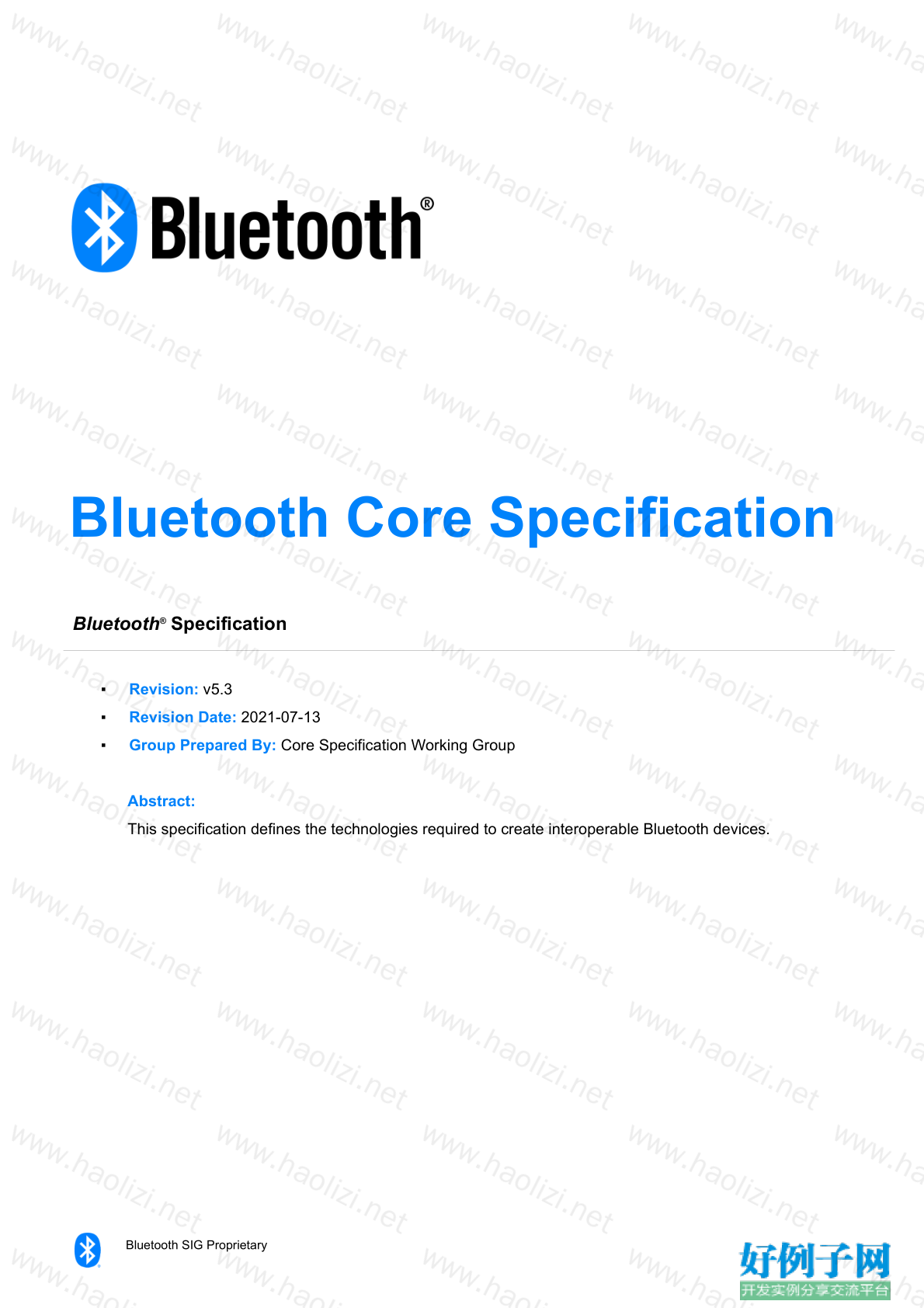

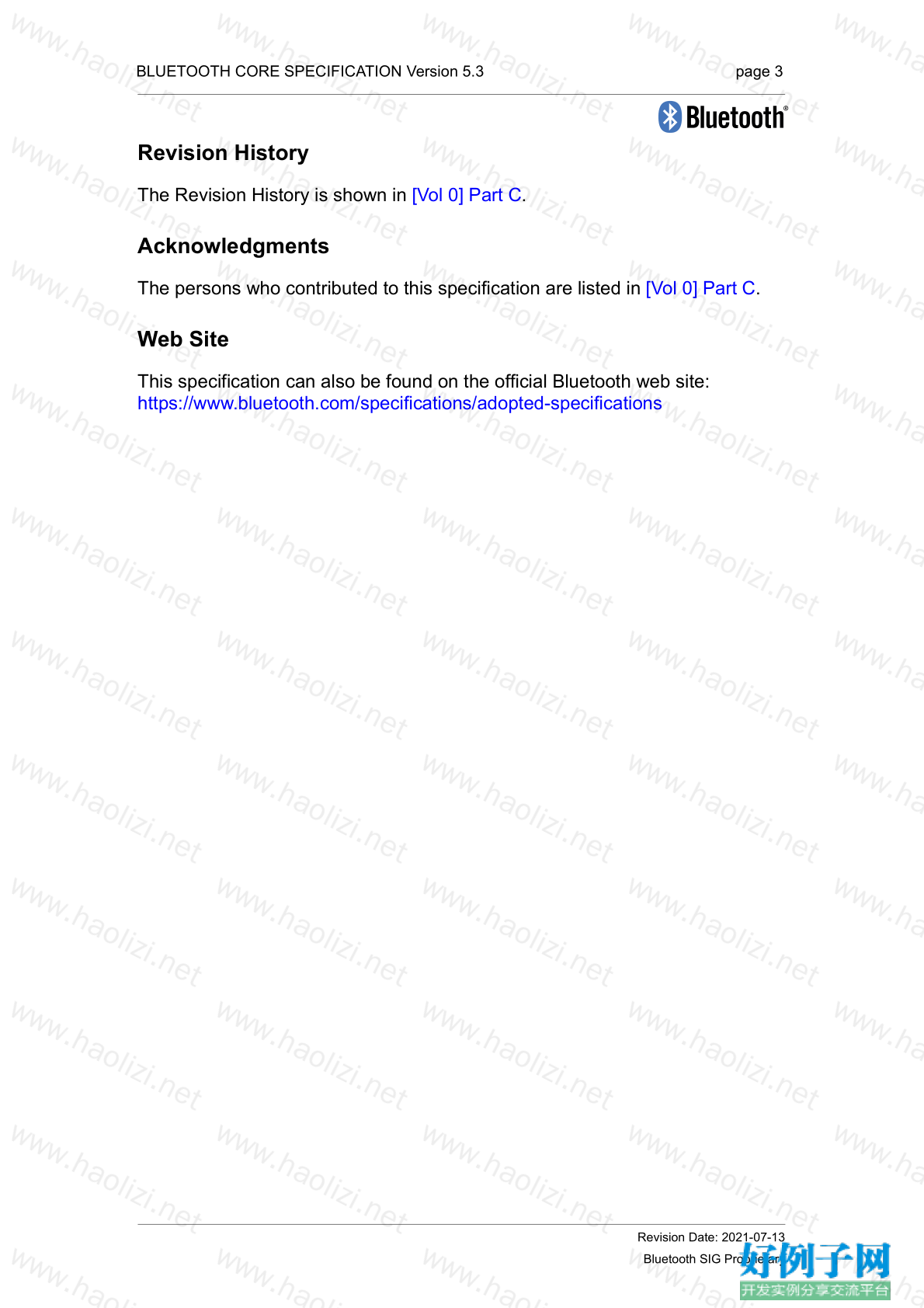
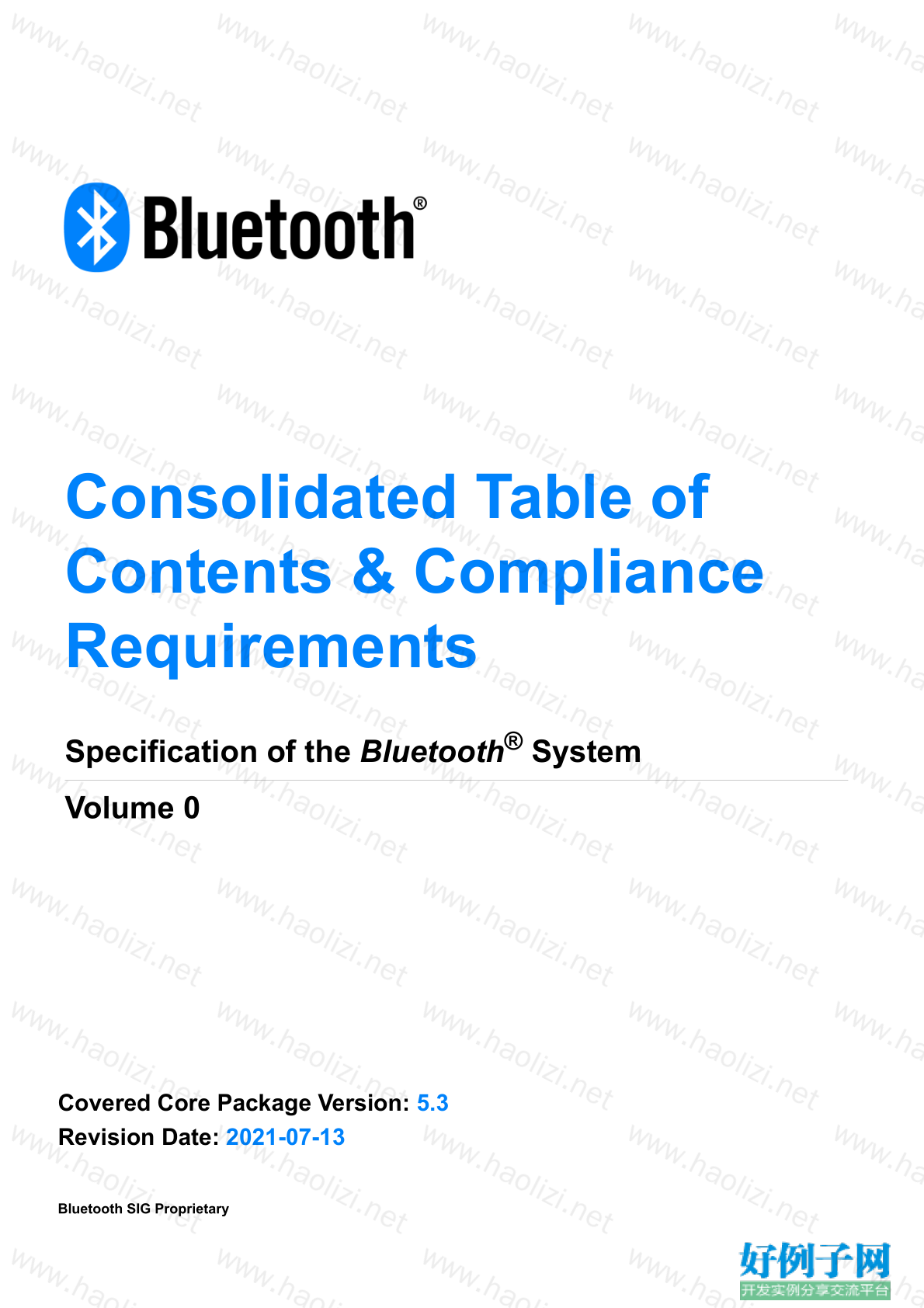
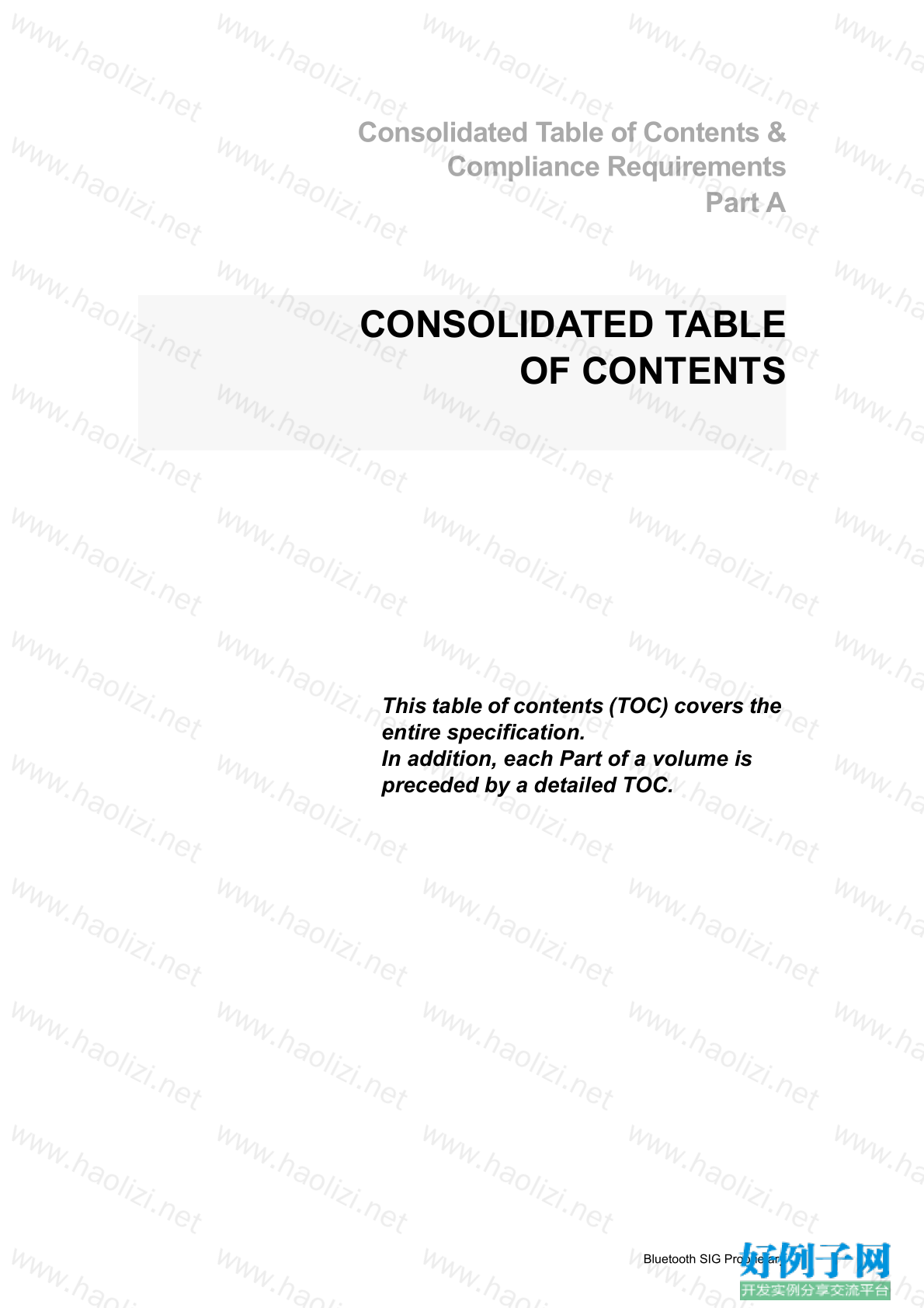
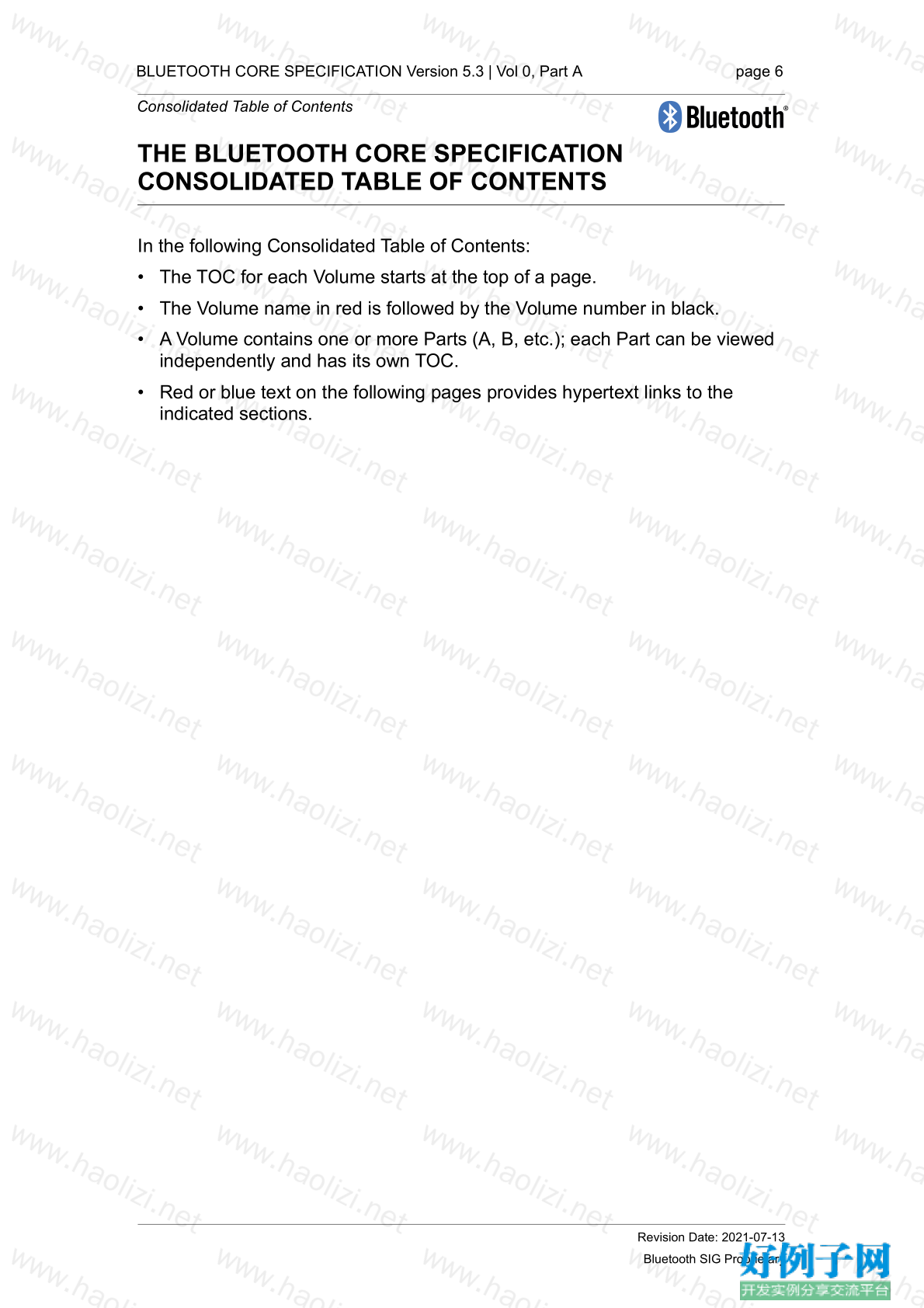


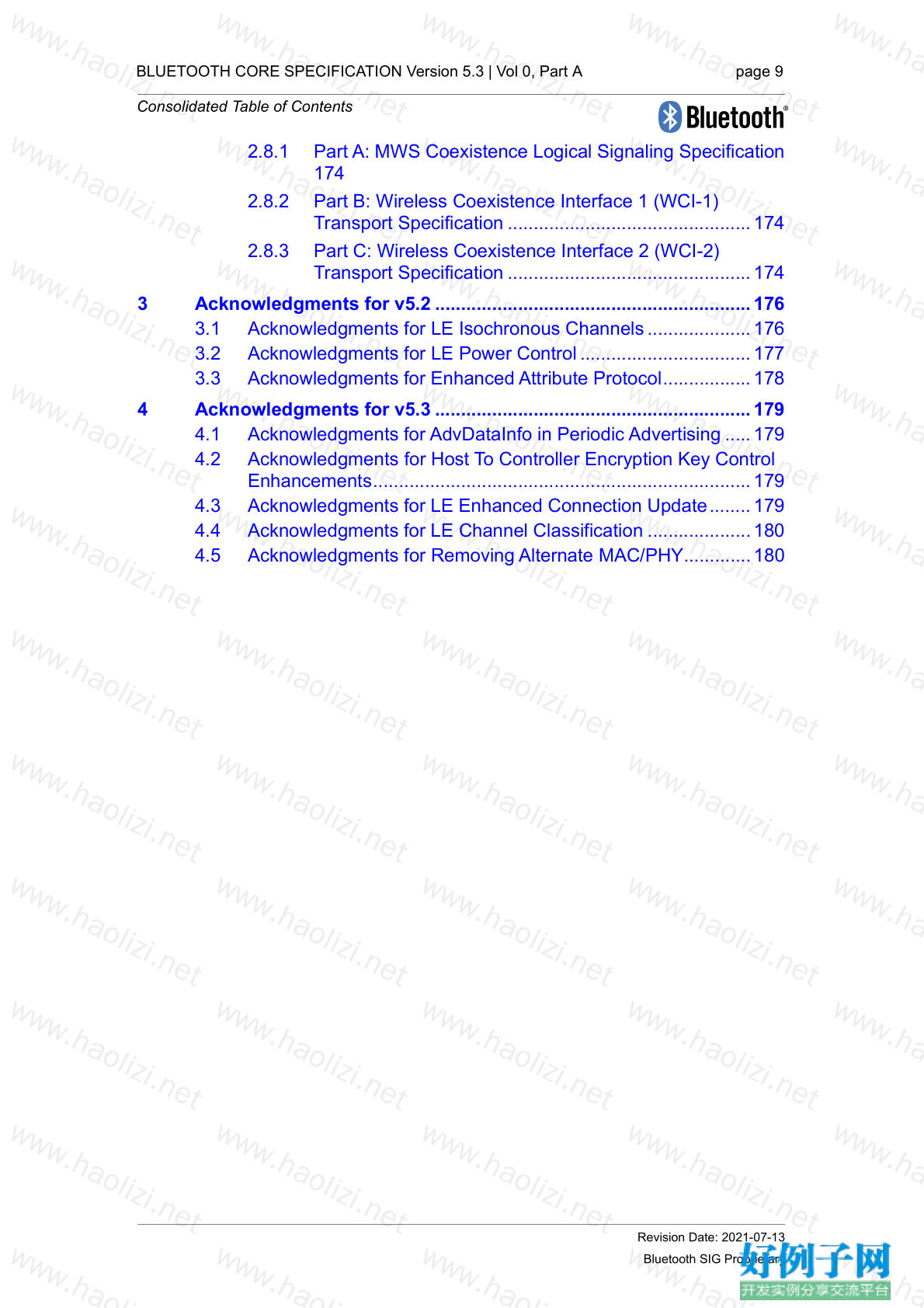

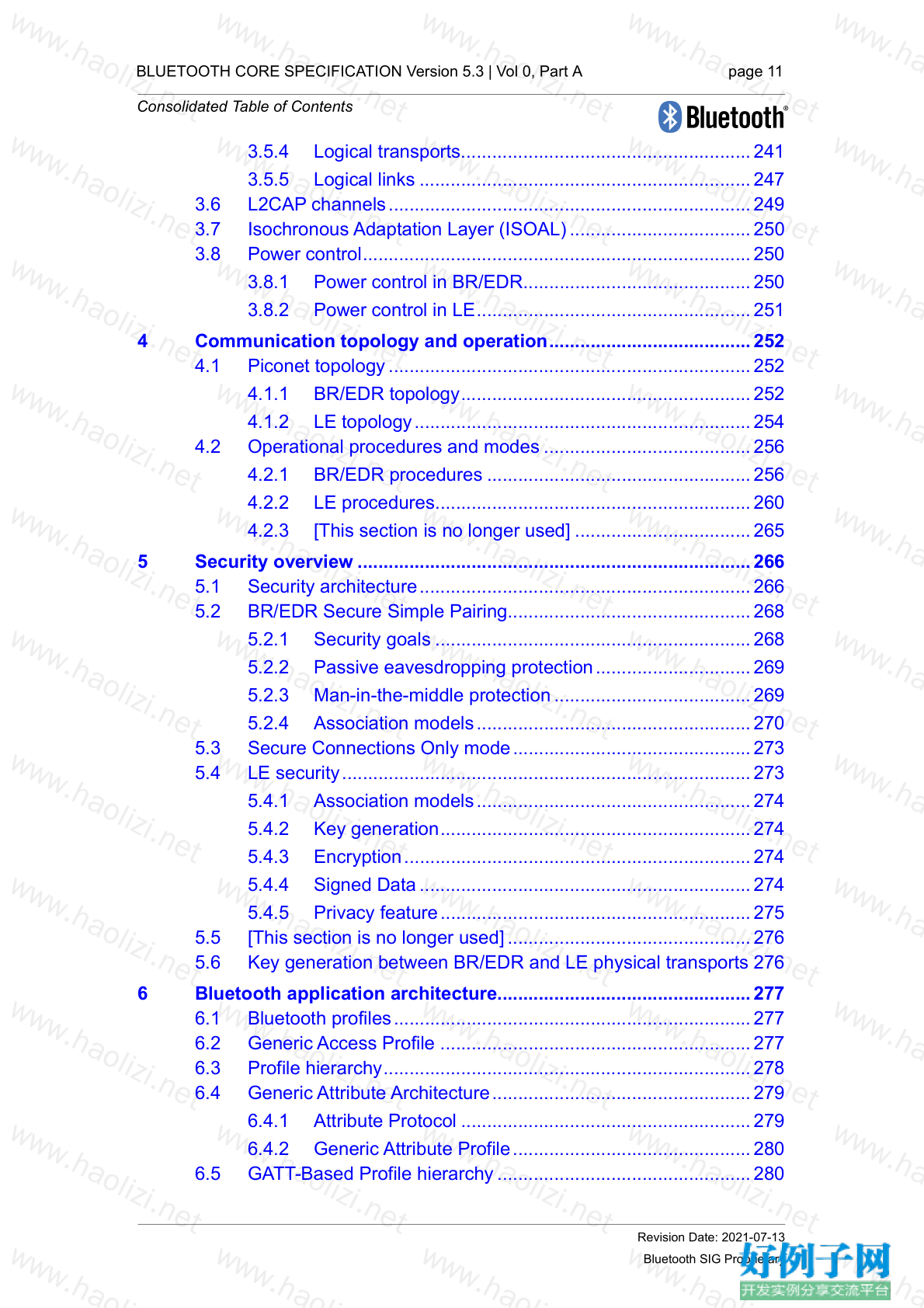
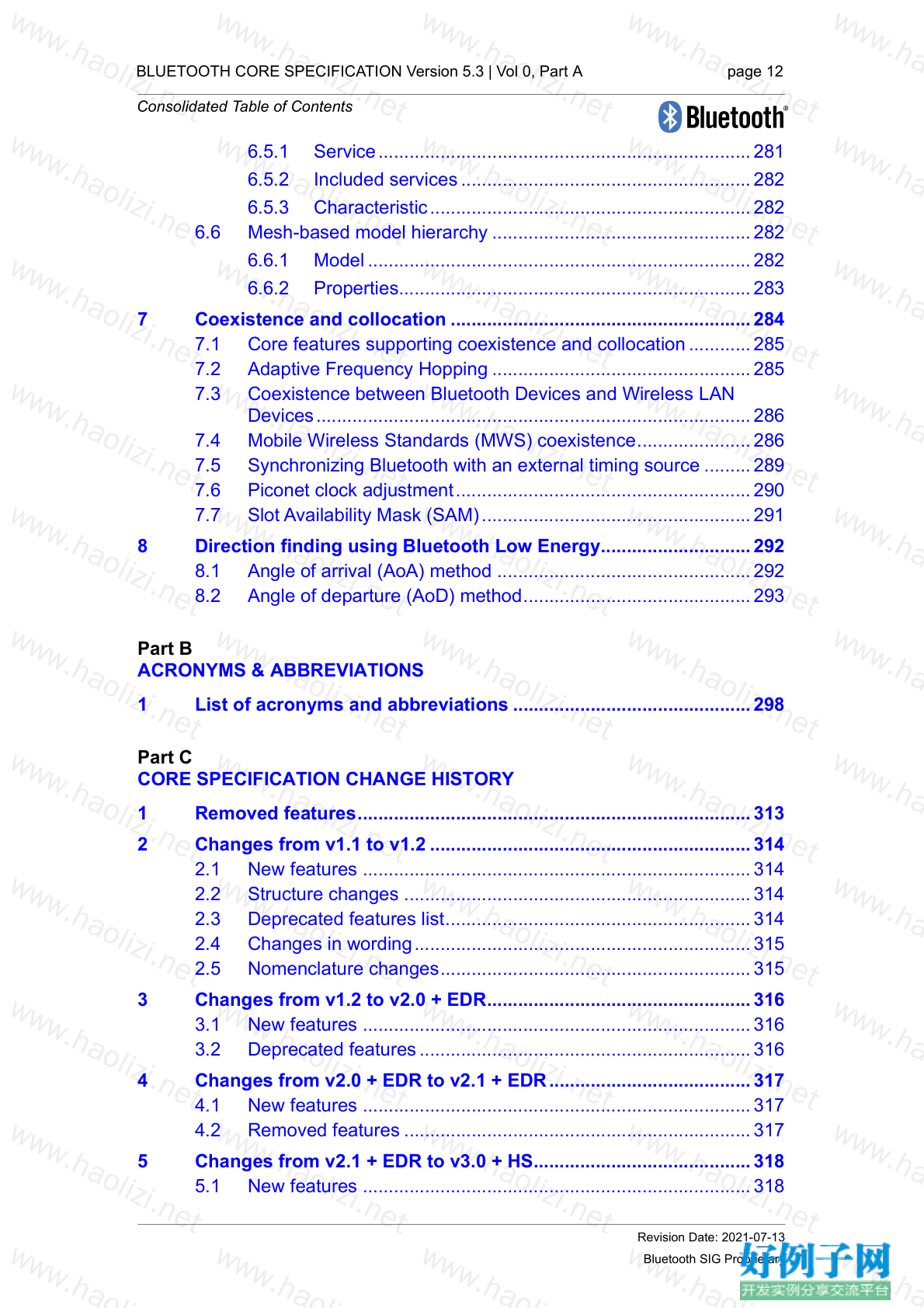
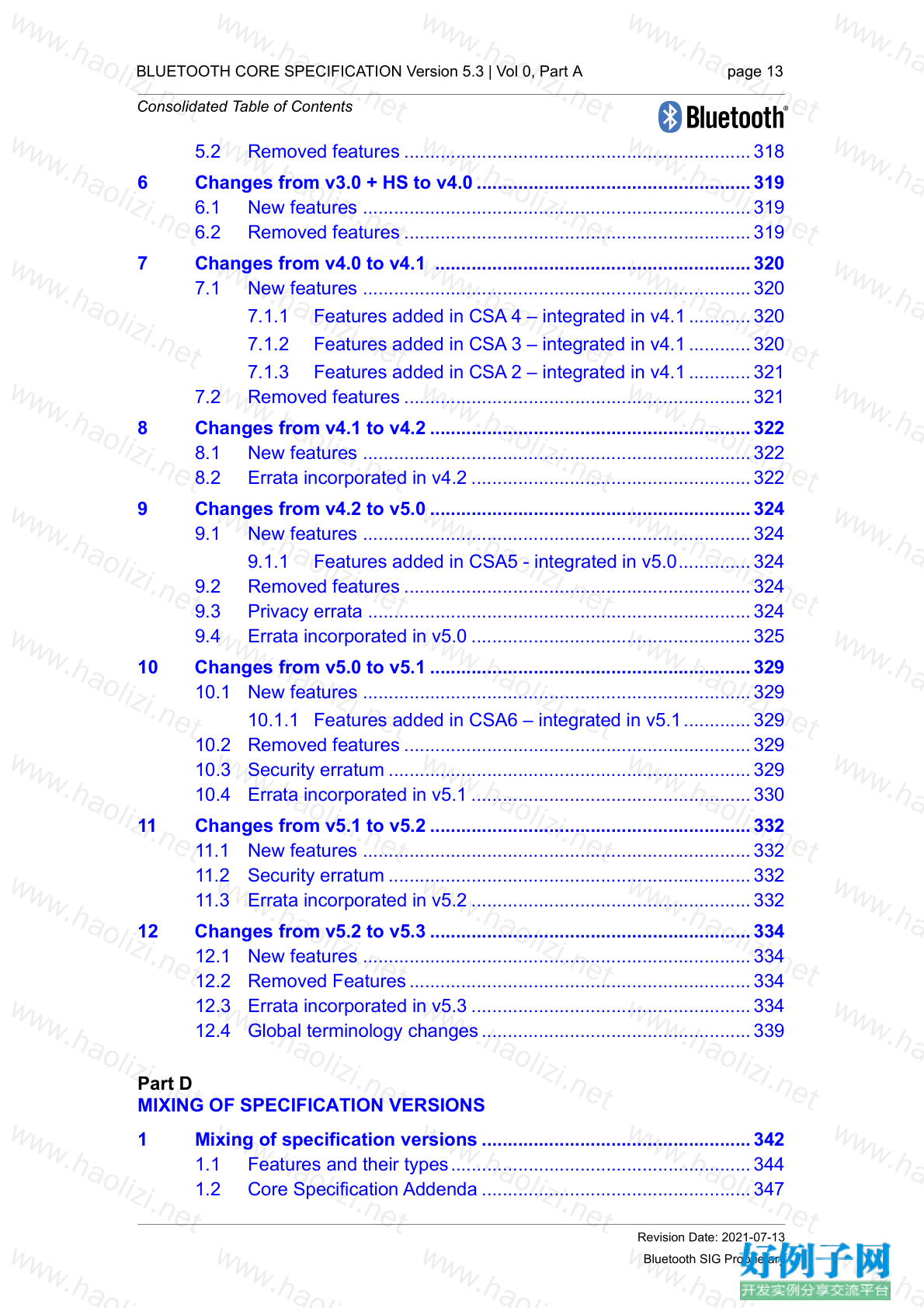
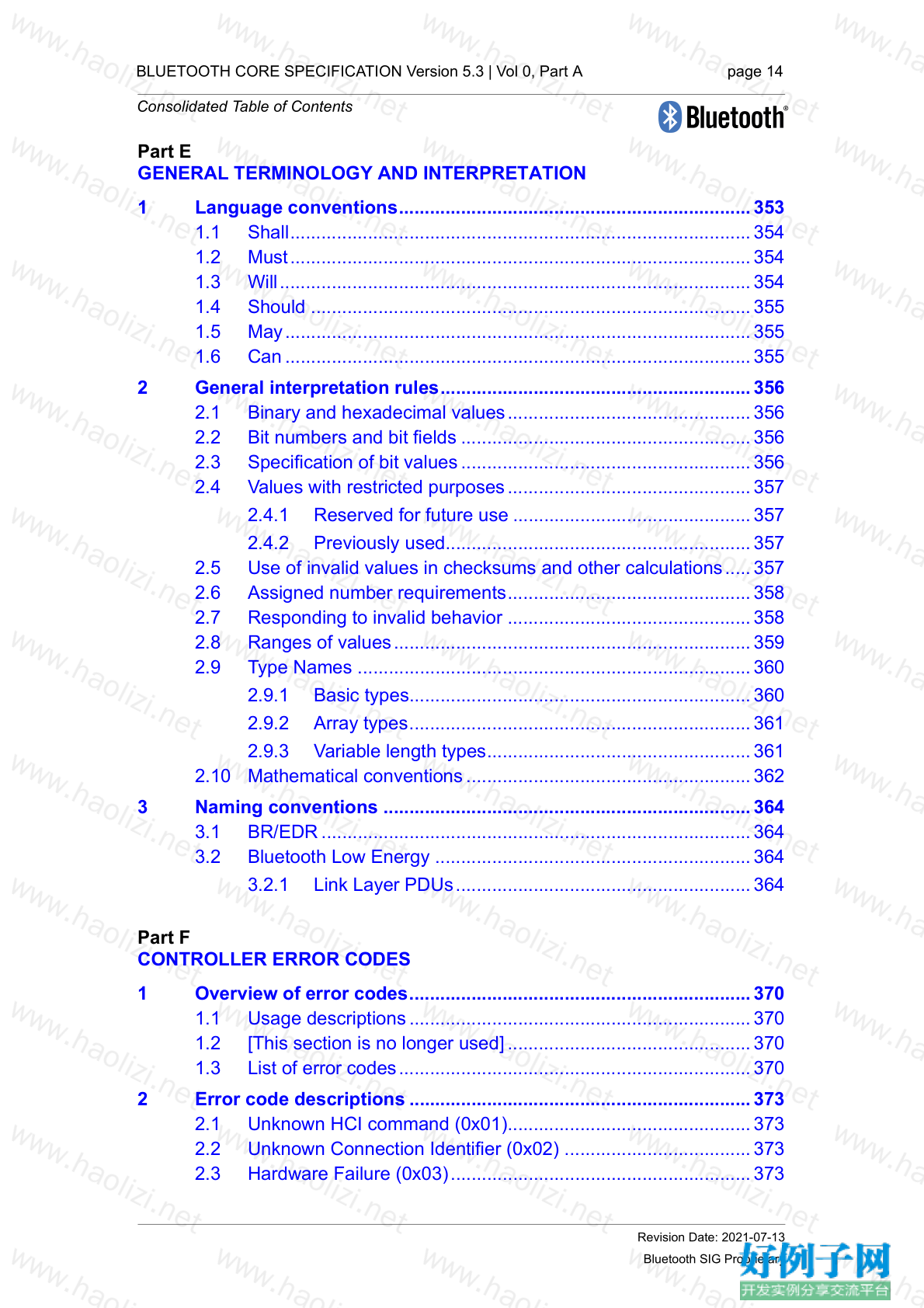

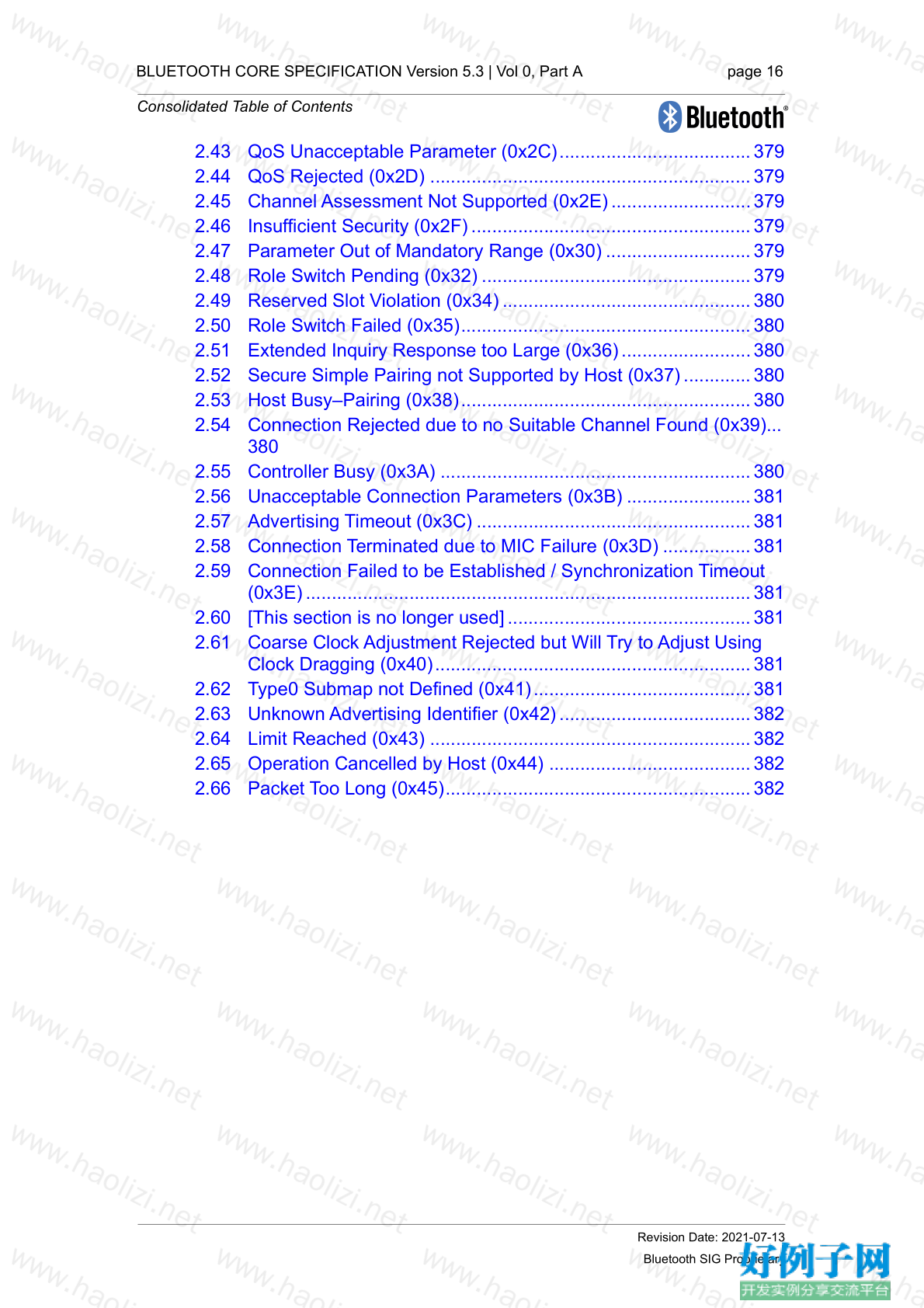

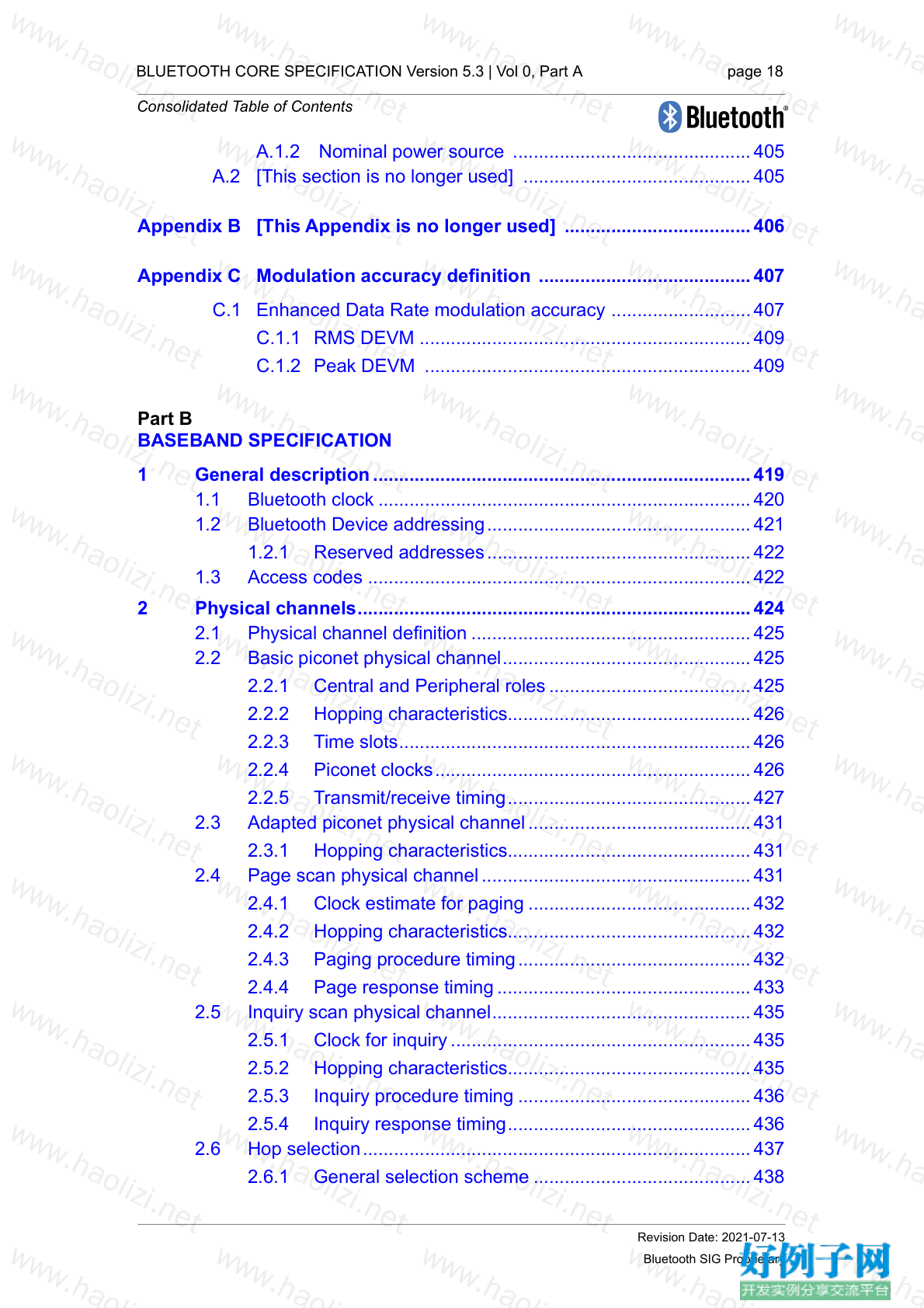
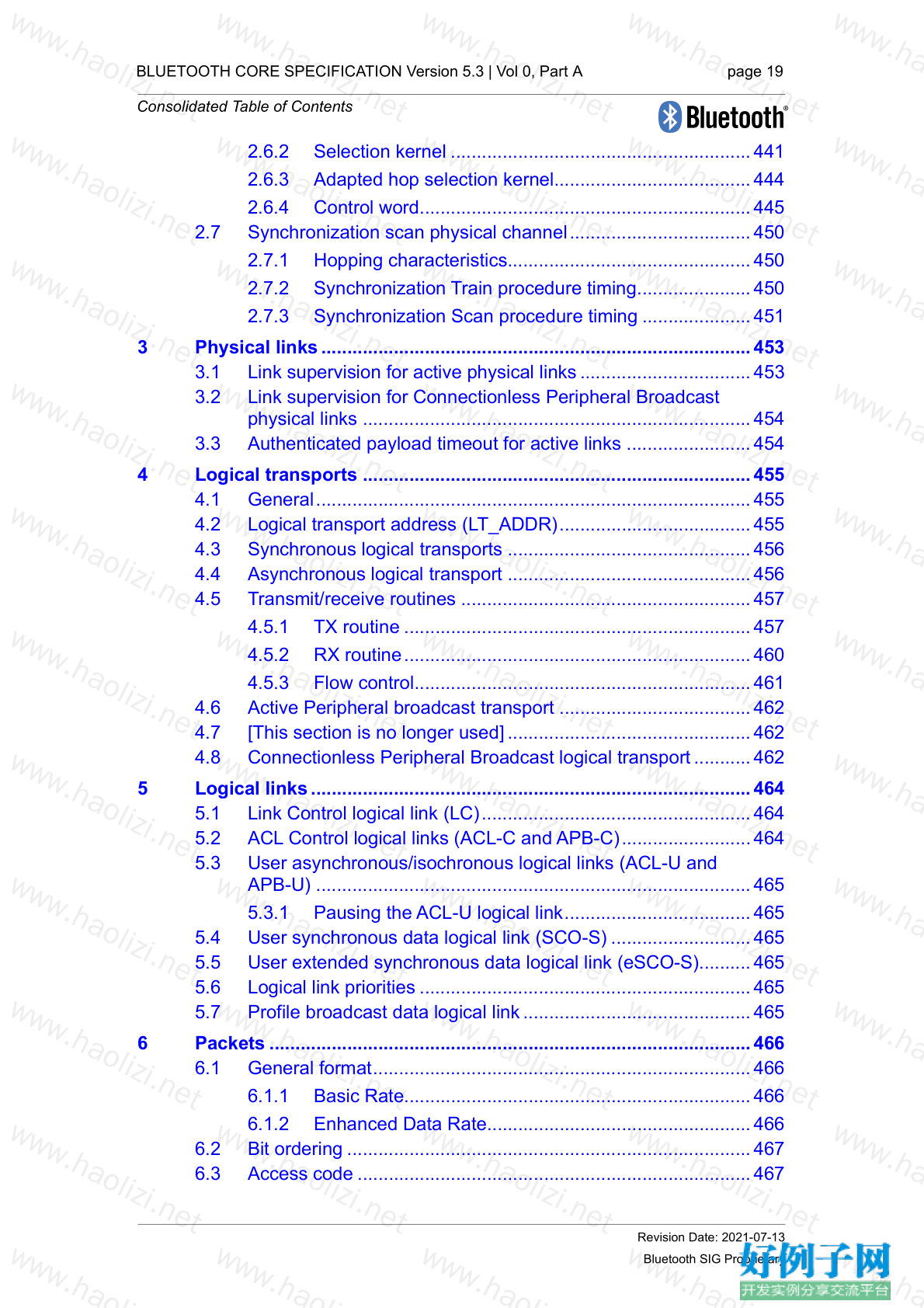
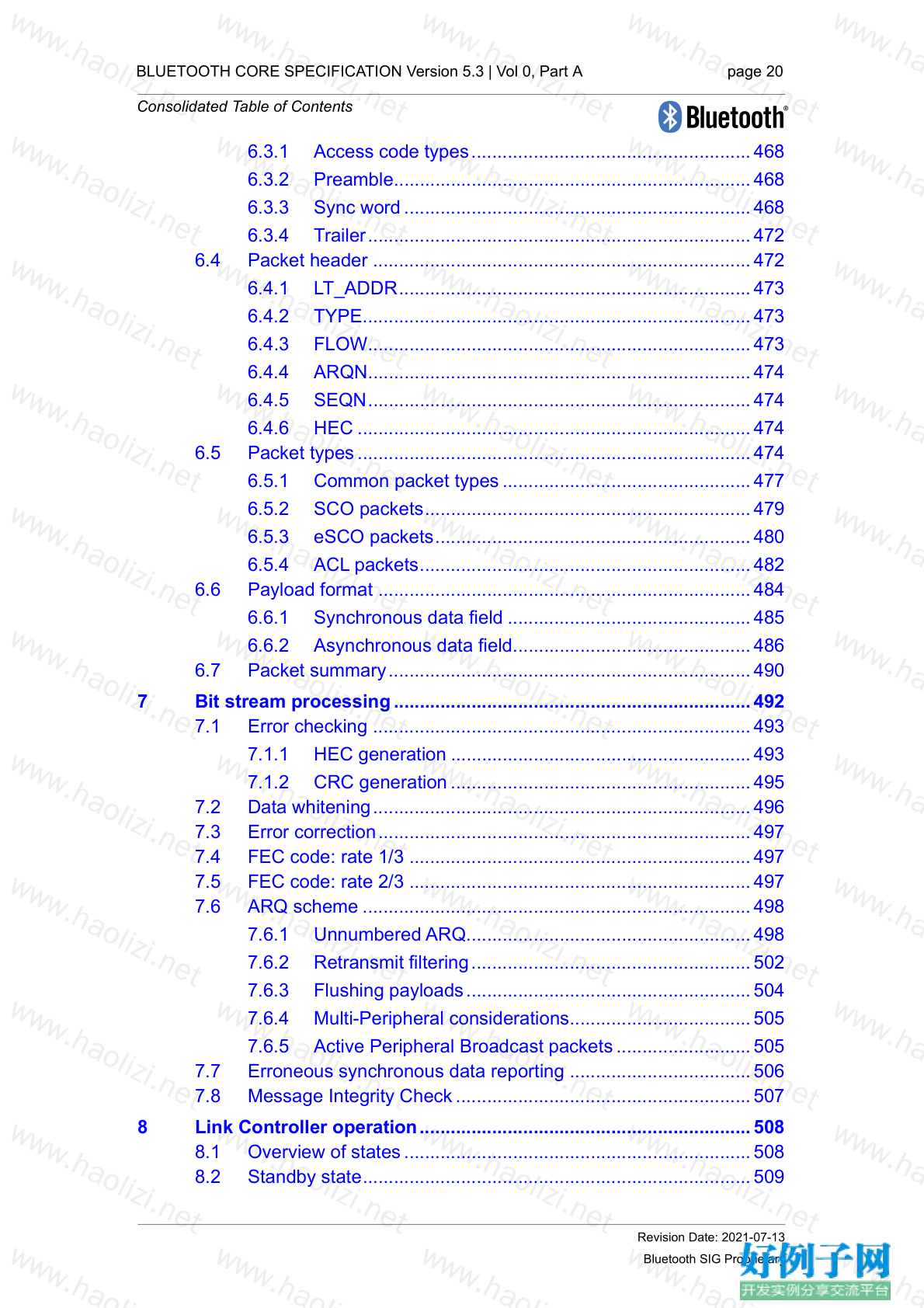
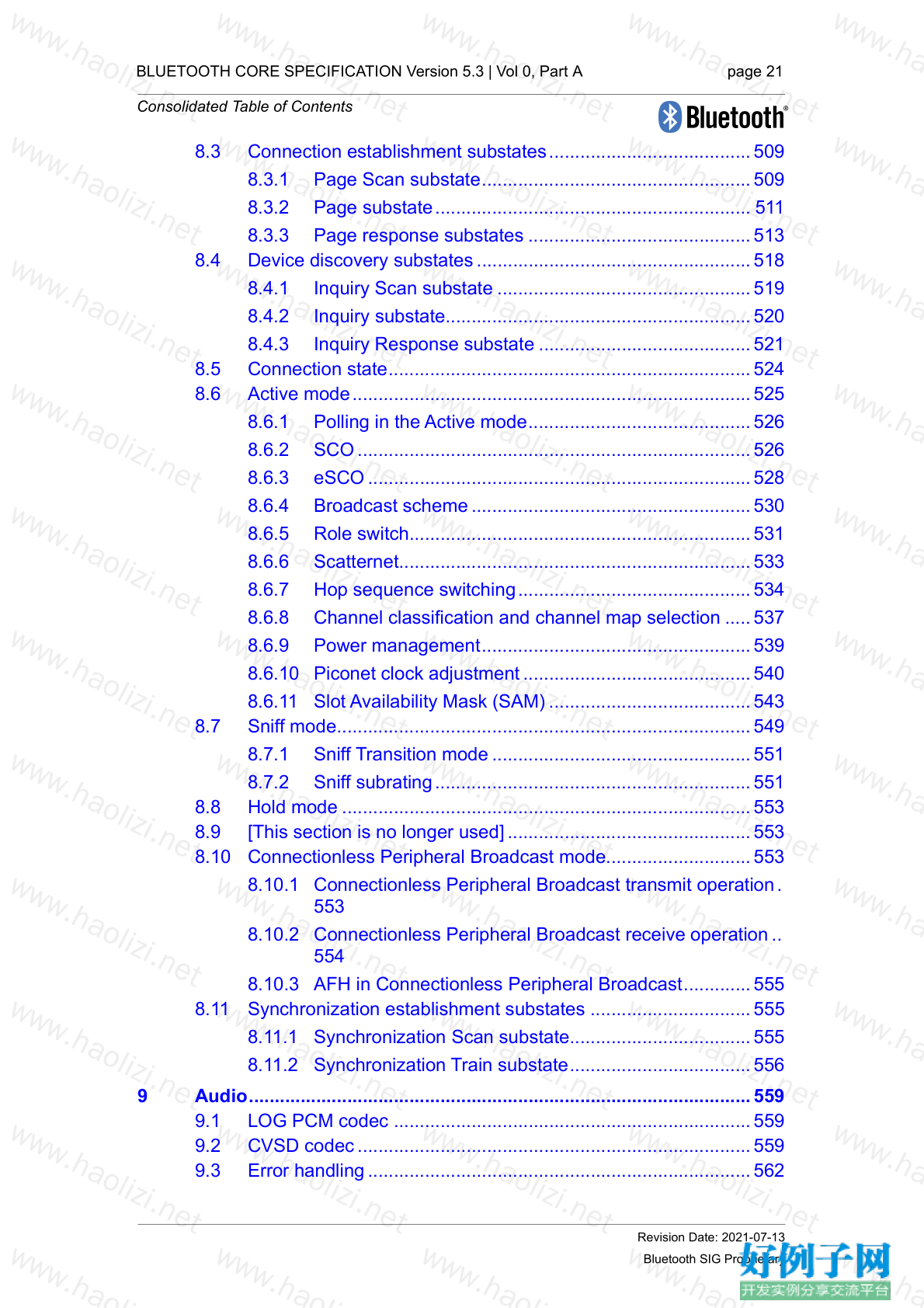
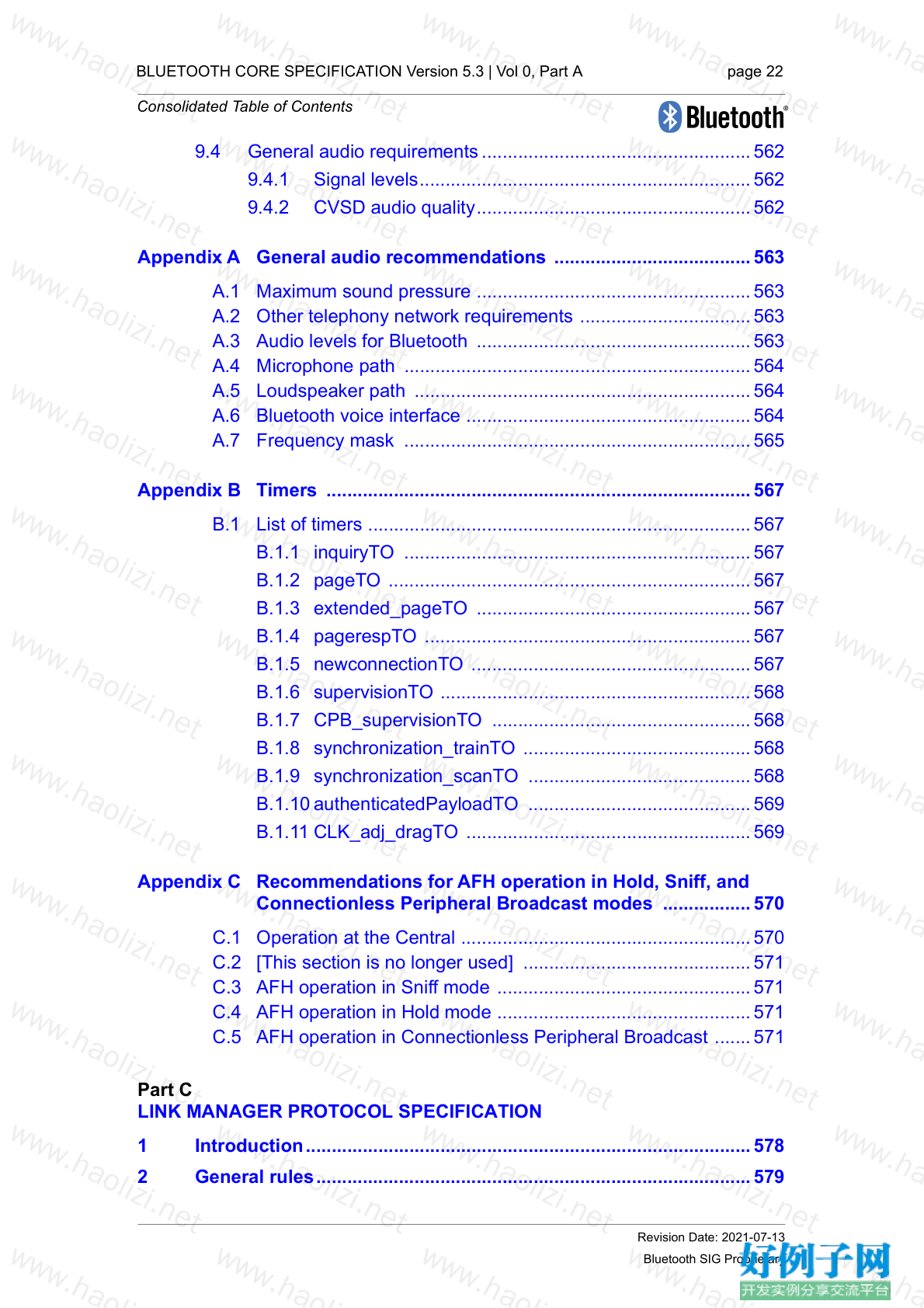
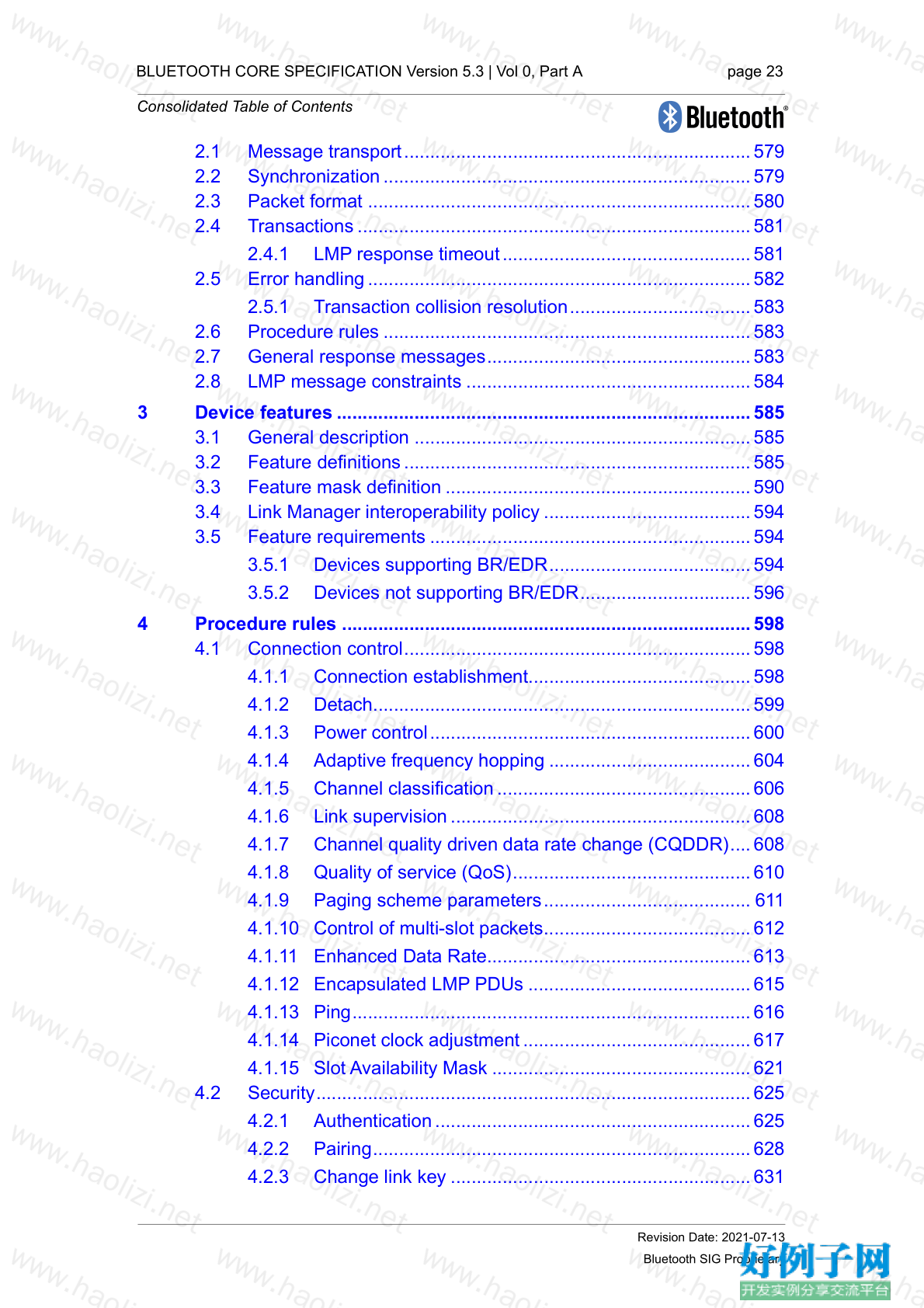
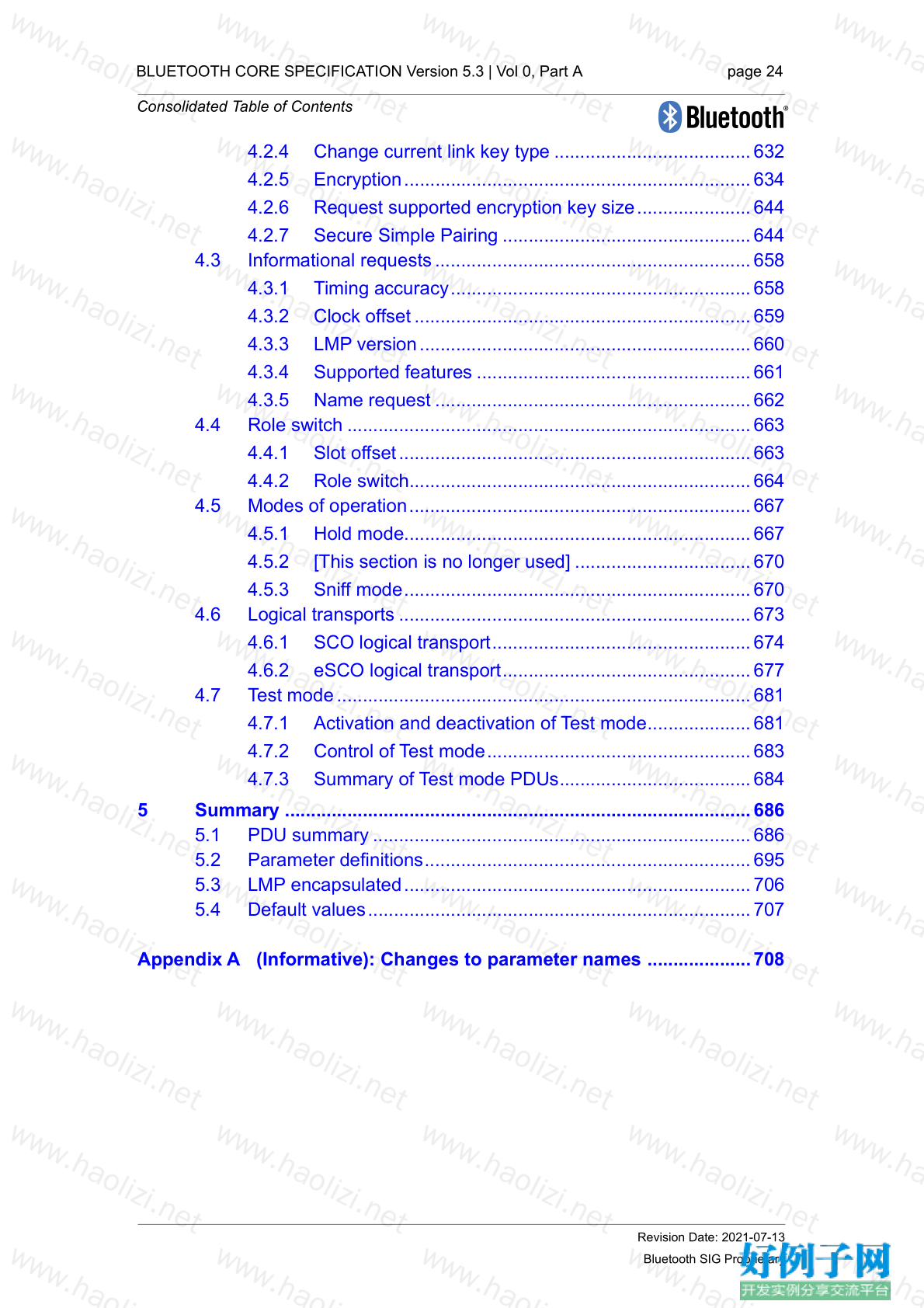
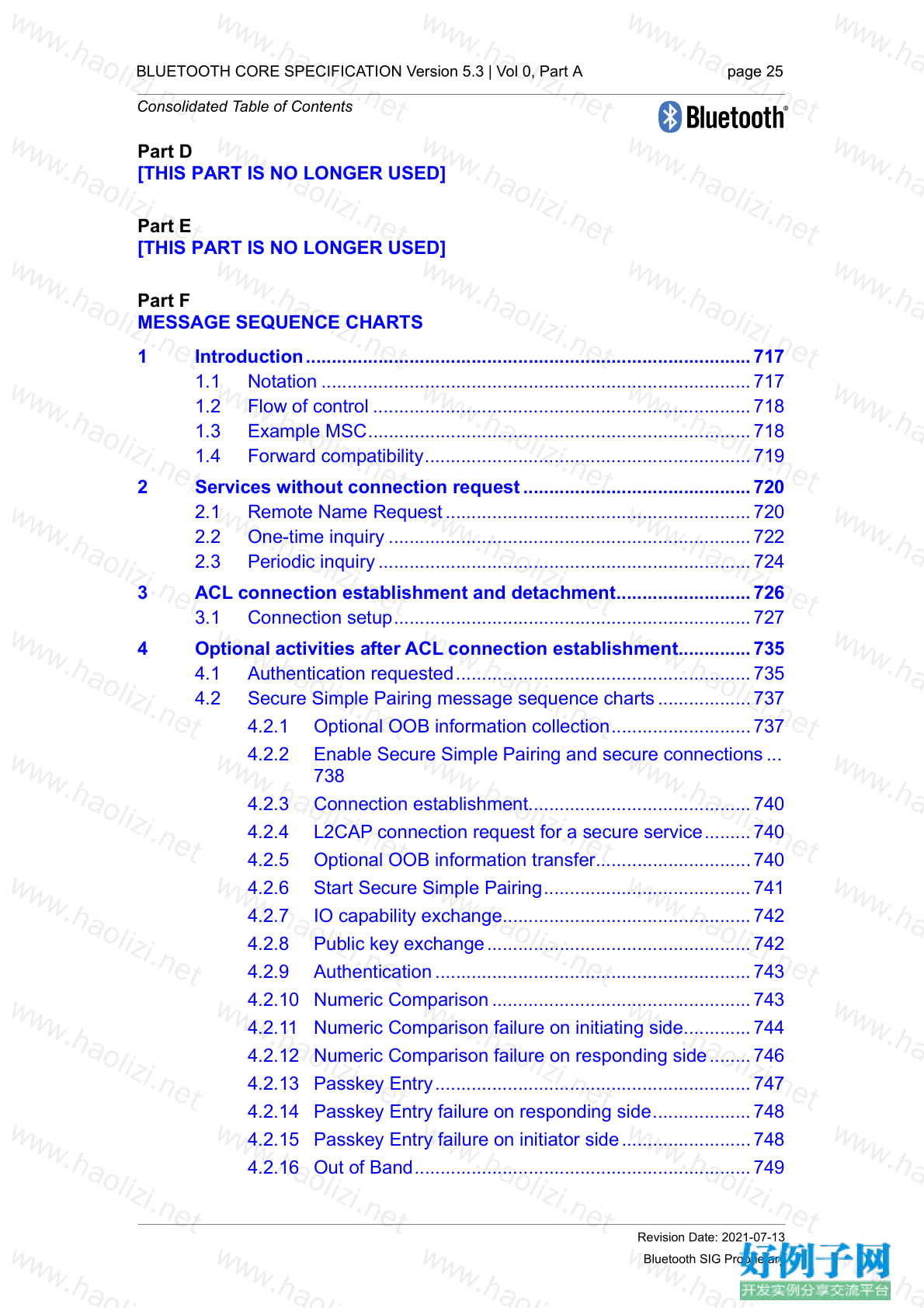

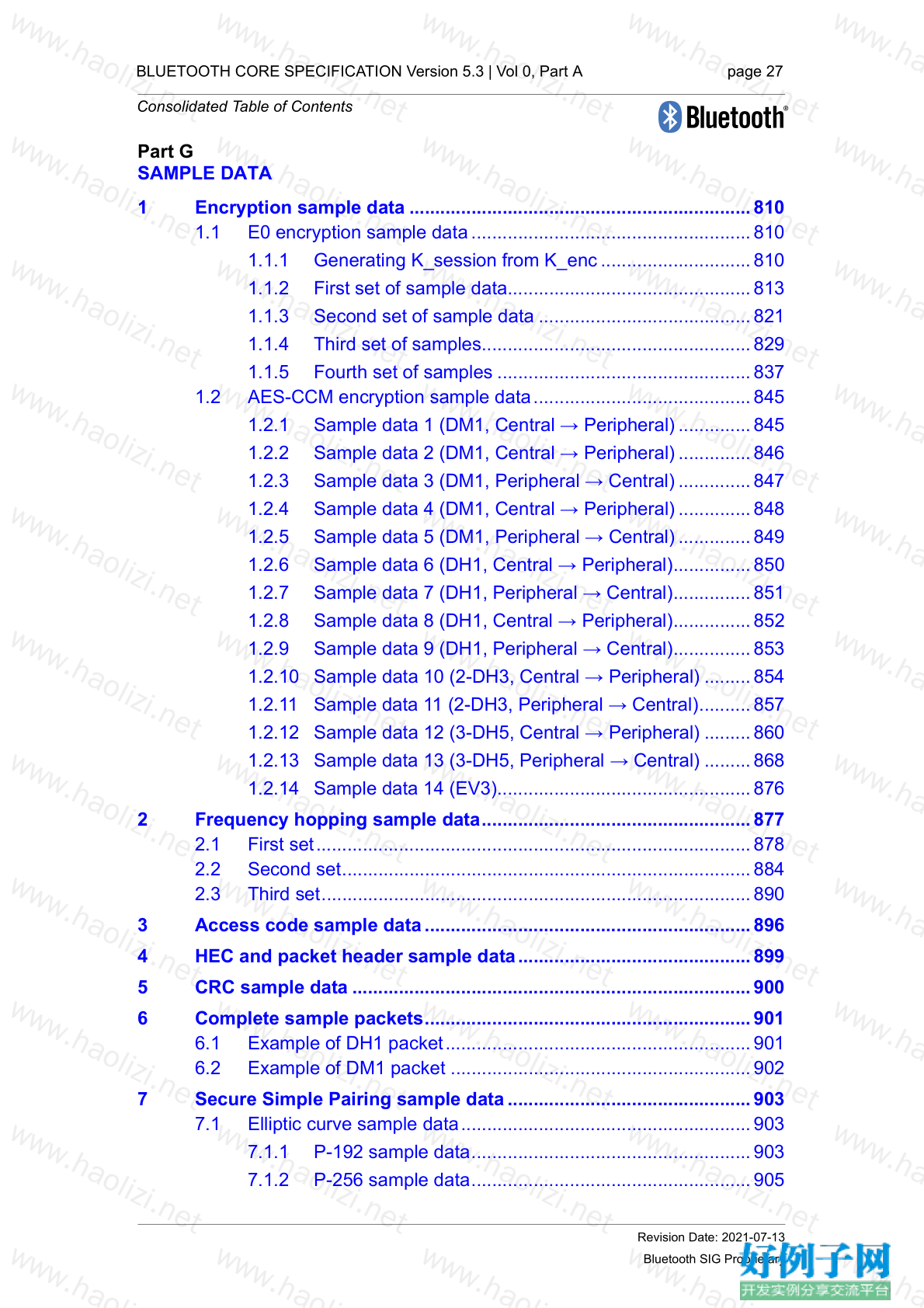

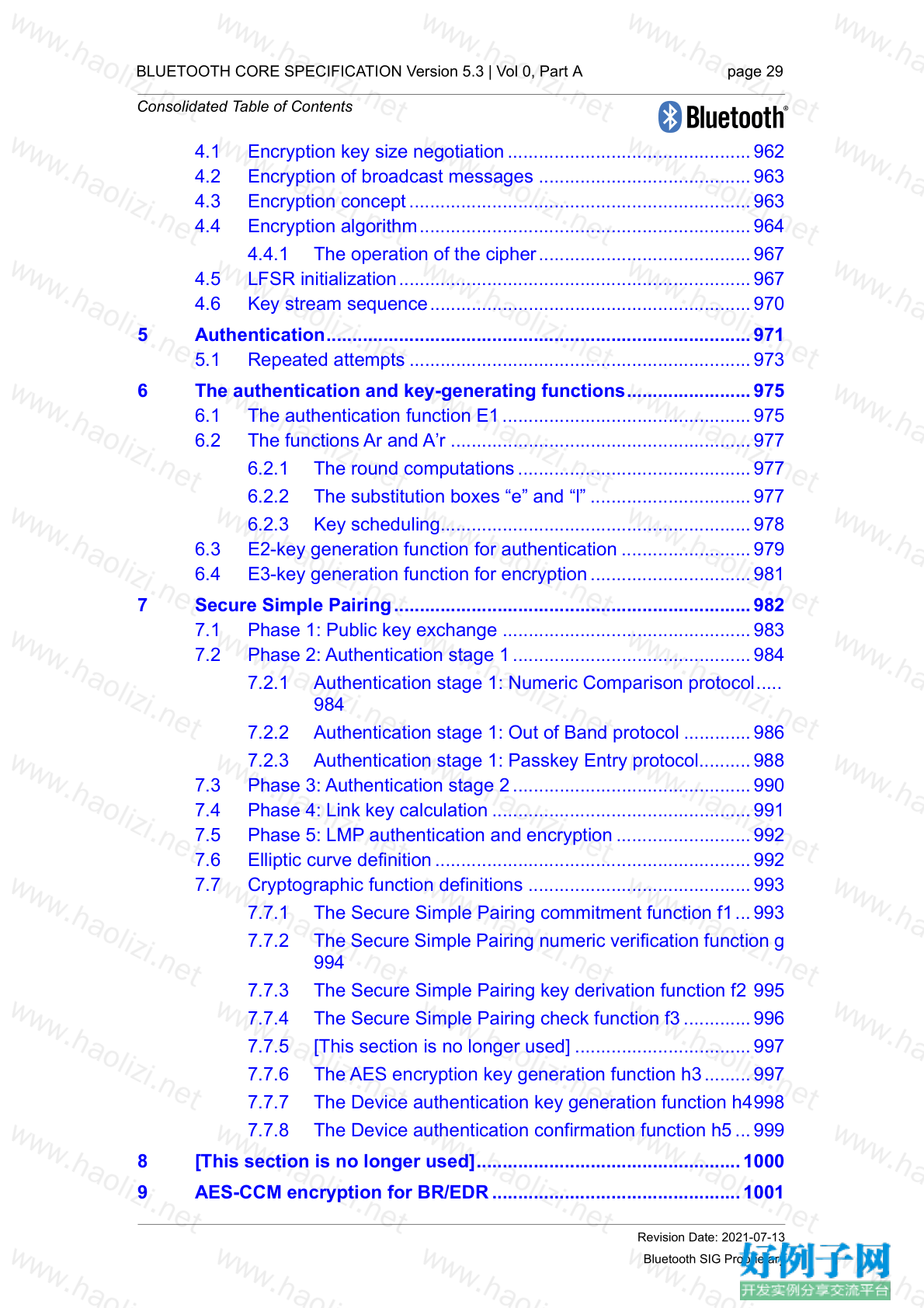
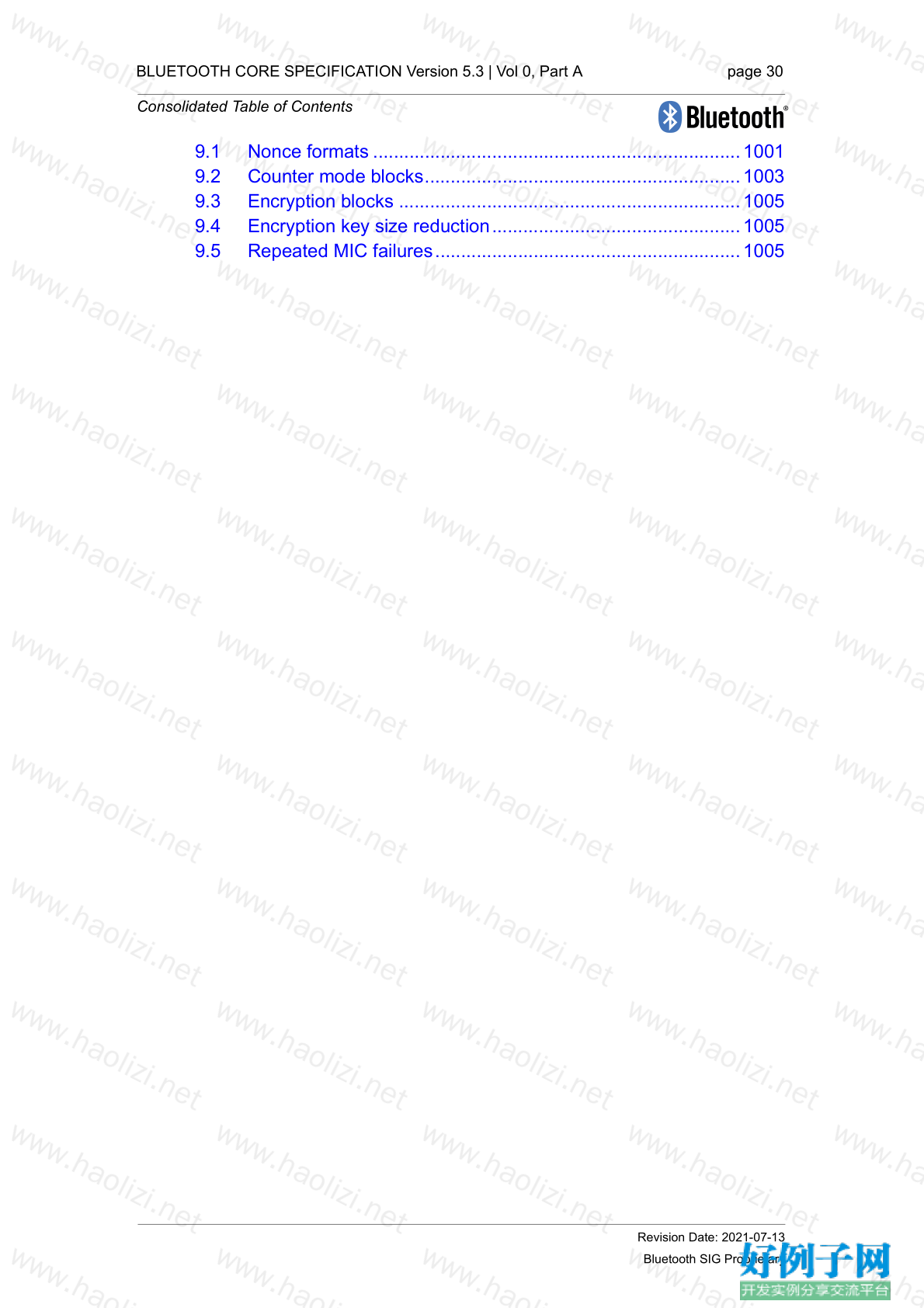
【核心代码】
Part B
BLUETOOTH COMPLIANCE REQUIREMENTS
1 Introduction........................................................................................84
2 Scope..................................................................................................85
3 Definitions ..........................................................................................86
3.1 Types of Bluetooth Products......................................................86
3.1.1 Bluetooth End Product..................................................87
3.1.2 Bluetooth Subsystem Product.......................................87
3.1.3 Bluetooth Component Product......................................90
3.1.4 Bluetooth Development Tool.........................................90
3.1.5 Bluetooth Test Equipment.............................................90
4 Core Configurations..........................................................................91
4.1 Basic Rate Core Configuration..................................................91
4.2 Enhanced Data Rate Core Configurations ................................92
4.3 [This section is no longer used].................................................93
4.4 Low Energy Core Configuration ................................................93
4.5 Basic Rate and Low Energy Combined Core Configuration......94
4.6 Host Controller Interface Core Configuration.............................95
Part C
REVISION HISTORY AND ACKNOWLEDGMENTS
1 Revision History ................................................................................99
1.1 [Vol 0] Consolidated TOC & Compliance Requirements ...........99
1.2 [Vol 1] Architecture, Mixing, and Conventions .........................100
1.3 [Vols 2, 3, 5, 6 & 7] Controllers and Host.................................101
1.4 [Vol 4] Host Controller Interface...............................................104
2 Acknowledgments (up to v5.1).......................................................105
2.1 [Vol 0] Consolidated TOC & Compliance Requirements .........105
2.1.1 Part B: Bluetooth Compliance Requirements ............105
2.1.2 Part C: Revision History and Acknowledgments.........105
2.2 [Vol 1] Architecture, Mixing, and Conventions .........................106
2.2.1 Part A: Architectural Overview ....................................106
Revision Date: 2021-07-13
Bluetooth SIG Proprietary
BLUETOOTH CORE SPECIFICATION Version 5.3 | Vol 0, Part A page 8
Consolidated Table of Contents
2.2.2 Part B: Acronyms & Abbreviations.............................. 110
2.2.3 Part C: Core Specification Change History................. 112
2.2.4 Part D: Mixing of Specification Versions..................... 112
2.2.5 Part E: General Terminology and Interpretation.......... 113
2.2.6 Part F: Controller Error Codes.................................... 114
2.3 [Vol 2] BR/EDR Controller ....................................................... 117
2.3.1 Part A: Radio Specification ......................................... 117
2.3.2 Part B: Baseband Specification .................................. 119
2.3.3 Part C: Link Manager Protocol....................................123
2.3.4 Part D: [This part is no longer used] ...........................127
2.3.5 Part E: [This part is no longer used]............................127
2.3.6 Part F: Message Sequence Charts.............................128
2.3.7 Part G: Sample Data...................................................130
2.3.8 Part H: Security Specification .....................................132
2.4 [Vol 3] Host ..............................................................................134
2.4.1 Part A: Logical Link Control and Adaptation Protocol
Specification................................................................134
2.4.2 Part B: Service Discovery Protocol (SDP)..................138
2.4.3 Part C: Generic Access Profile....................................139
2.4.4 Part D: Test Support....................................................144
2.4.5 Part E: AMP Manager Protocol...................................145
2.4.6 Part F: Attribute Protocol Specification .......................145
2.4.7 Part G: Generic Attribute Profile Specification............147
2.4.8 Part H: Security Manager Specification......................148
2.5 [Vol 4] Host Controller Interface...............................................150
2.5.1 Parts A to D: Transport Layers....................................150
2.5.2 Part E: Bluetooth Host Controller Interface Functional
Specification................................................................151
2.6 [Vol 5] AMP Controller..............................................................159
2.6.1 Part A: 802.11 PAL......................................................159
2.7 [Vol 6] Low Energy Controller..................................................160
2.7.1 Part A: Physical Layer Specification ...........................160
2.7.2 Part B: Link Layer Specification..................................162
2.7.3 Part C: Sample Data...................................................166
2.7.4 Part D: Message Sequence Charts ............................167
2.7.5 Part E: Low Energy Security Specification..................170
2.7.6 Part F: Direct Test Mode.............................................171
2.8 [Vol 7] Wireless Coexistence Signaling and Interfaces............174
Revision Date: 2021-07-13
Bluetooth SIG Proprietary
BLUETOOTH CORE SPECIFICATION Version 5.3 | Vol 0, Part A page 9
Consolidated Table of Contents
2.8.1 Part A: MWS Coexistence Logical Signaling Specification
174
2.8.2 Part B: Wireless Coexistence Interface 1 (WCI-1)
Transport Specification ...............................................174
2.8.3 Part C: Wireless Coexistence Interface 2 (WCI-2)
Transport Specification ...............................................174
3 Acknowledgments for v5.2 .............................................................176
3.1 Acknowledgments for LE Isochronous Channels....................176
3.2 Acknowledgments for LE Power Control.................................177
3.3 Acknowledgments for Enhanced Attribute Protocol.................178
4 Acknowledgments for v5.3 .............................................................179
4.1 Acknowledgments for AdvDataInfo in Periodic Advertising .....179
4.2 Acknowledgments for Host To Controller Encryption Key Control
Enhancements.........................................................................179
4.3 Acknowledgments for LE Enhanced Connection Update........179
4.4 Acknowledgments for LE Channel Classification ....................180
4.5 Acknowledgments for Removing Alternate MAC/PHY.............180
Revision Date: 2021-07-13
Bluetooth SIG Proprietary
BLUETOOTH CORE SPECIFICATION Version 5.3 | Vol 0, Part A page 10
Consolidated Table of Contents
Architecture, Mixing, and Conventions
Specification Volume 1
Part A
ARCHITECTURE
1 General description.........................................................................187
1.1 Overview of BR/EDR operation...............................................188
1.2 Overview of Bluetooth Low Energy operation .........................190
1.3 [This section is no longer used]...............................................195
1.4 Nomenclature ..........................................................................195
2 Core system architecture................................................................202
2.1 Core architectural blocks.........................................................205
2.1.1 Host architectural blocks.............................................206
2.1.2 BR/EDR/LE Controller architectural blocks.................207
2.1.3 [This section is no longer used] ..................................209
3 Data transport architecture.............................................................210
3.1 Core traffic bearers.................................................................. 211
3.1.1 Framed data traffic......................................................212
3.1.2 Unframed data traffic ..................................................213
3.1.3 Reliability of traffic bearers..........................................214
3.2 Transport architecture entities .................................................216
3.2.1 BR/EDR generic packet structure...............................216
3.2.2 LE generic packet structure........................................218
3.3 Physical channels....................................................................222
3.3.1 BR/EDR physical channels.........................................222
3.3.2 LE physical channels..................................................228
3.3.3 [This section is no longer used] ..................................234
3.4 Physical links...........................................................................234
3.4.1 BR/EDR links supported by the basic and adapted piconet
physical channels........................................................235
3.4.2 BR/EDR links supported by the scanning physical
channels......................................................................236
3.4.3 LE links supported by the LE physical channels.........236
3.4.4 [This section is no longer used] ..................................237
3.5 Logical links and logical transports..........................................237
3.5.1 Casting........................................................................240
3.5.2 Scheduling and acknowledgment scheme..................240
3.5.3 Class of data...............................................................240
Revision Date: 2021-07-13
Bluetooth SIG Proprietary
BLUETOOTH CORE SPECIFICATION Version 5.3 | Vol 0, Part A page 11
Consolidated Table of Contents
3.5.4 Logical transports........................................................241
3.5.5 Logical links ................................................................247
3.6 L2CAP channels......................................................................249
3.7 Isochronous Adaptation Layer (ISOAL)...................................250
3.8 Power control...........................................................................250
3.8.1 Power control in BR/EDR............................................250
3.8.2 Power control in LE.....................................................251
4 Communication topology and operation.......................................252
4.1 Piconet topology......................................................................252
4.1.1 BR/EDR topology........................................................252
4.1.2 LE topology.................................................................254
4.2 Operational procedures and modes ........................................256
4.2.1 BR/EDR procedures ...................................................256
4.2.2 LE procedures.............................................................260
4.2.3 [This section is no longer used] ..................................265
5 Security overview ............................................................................266
5.1 Security architecture................................................................266
5.2 BR/EDR Secure Simple Pairing...............................................268
5.2.1 Security goals .............................................................268
5.2.2 Passive eavesdropping protection..............................269
5.2.3 Man-in-the-middle protection......................................269
5.2.4 Association models.....................................................270
5.3 Secure Connections Only mode..............................................273
5.4 LE security...............................................................................273
5.4.1 Association models.....................................................274
5.4.2 Key generation............................................................274
5.4.3 Encryption...................................................................274
5.4.4 Signed Data................................................................274
5.4.5 Privacy feature............................................................275
5.5 [This section is no longer used]...............................................276
5.6 Key generation between BR/EDR and LE physical transports 276
6 Bluetooth application architecture.................................................277
6.1 Bluetooth profiles.....................................................................277
6.2 Generic Access Profile ............................................................277
6.3 Profile hierarchy.......................................................................278
6.4 Generic Attribute Architecture..................................................279
6.4.1 Attribute Protocol ........................................................279
6.4.2 Generic Attribute Profile..............................................280
6.5 GATT-Based Profile hierarchy.................................................280
Revision Date: 2021-07-13
Bluetooth SIG Proprietary
BLUETOOTH CORE SPECIFICATION Version 5.3 | Vol 0, Part A page 12
Consolidated Table of Contents
6.5.1 Service........................................................................281
6.5.2 Included services........................................................282
6.5.3 Characteristic..............................................................282
6.6 Mesh-based model hierarchy ..................................................282
6.6.1 Model..........................................................................282
6.6.2 Properties....................................................................283
7 Coexistence and collocation ..........................................................284
7.1 Core features supporting coexistence and collocation............285
7.2 Adaptive Frequency Hopping ..................................................285
7.3 Coexistence between Bluetooth Devices and Wireless LAN
Devices....................................................................................286
7.4 Mobile Wireless Standards (MWS) coexistence......................286
7.5 Synchronizing Bluetooth with an external timing source .........289
7.6 Piconet clock adjustment.........................................................290
7.7 Slot Availability Mask (SAM)....................................................291
8 Direction finding using Bluetooth Low Energy.............................292
8.1 Angle of arrival (AoA) method .................................................292
8.2 Angle of departure (AoD) method............................................293
Part B
ACRONYMS & ABBREVIATIONS
1 List of acronyms and abbreviations ..............................................298
Part C
CORE SPECIFICATION CHANGE HISTORY
1 Removed features............................................................................313
2 Changes from v1.1 to v1.2 ..............................................................314
2.1 New features ...........................................................................314
2.2 Structure changes ...................................................................314
2.3 Deprecated features list...........................................................314
2.4 Changes in wording.................................................................315
2.5 Nomenclature changes............................................................315
3 Changes from v1.2 to v2.0 EDR...................................................316
3.1 New features ...........................................................................316
3.2 Deprecated features................................................................316
4 Changes from v2.0 EDR to v2.1 EDR.......................................317
4.1 New features ...........................................................................317
4.2 Removed features ...................................................................317
5 Changes from v2.1 EDR to v3.0 HS..........................................318
5.1 New features ...........................................................................318
Revision Date: 2021-07-13
Bluetooth SIG Proprietary
BLUETOOTH CORE SPECIFICATION Version 5.3 | Vol 0, Part A page 13
Consolidated Table of Contents
5.2 Removed features ...................................................................318
6 Changes from v3.0 HS to v4.0.....................................................319
6.1 New features ...........................................................................319
6.2 Removed features ...................................................................319
7 Changes from v4.0 to v4.1 .............................................................320
7.1 New features ...........................................................................320
7.1.1 Features added in CSA 4 – integrated in v4.1............320
7.1.2 Features added in CSA 3 – integrated in v4.1............320
7.1.3 Features added in CSA 2 – integrated in v4.1............321
7.2 Removed features ...................................................................321
8 Changes from v4.1 to v4.2 ..............................................................322
8.1 New features ...........................................................................322
8.2 Errata incorporated in v4.2 ......................................................322
9 Changes from v4.2 to v5.0 ..............................................................324
9.1 New features ...........................................................................324
9.1.1 Features added in CSA5 - integrated in v5.0..............324
9.2 Removed features ...................................................................324
9.3 Privacy errata ..........................................................................324
9.4 Errata incorporated in v5.0 ......................................................325
10 Changes from v5.0 to v5.1 ..............................................................329
10.1 New features ...........................................................................329
10.1.1 Features added in CSA6 – integrated in v5.1.............329
10.2 Removed features ...................................................................329
10.3 Security erratum ......................................................................329
10.4 Errata incorporated in v5.1 ......................................................330
11 Changes from v5.1 to v5.2 ..............................................................332
11.1 New features ...........................................................................332
11.2 Security erratum ......................................................................332
11.3 Errata incorporated in v5.2 ......................................................332
12 Changes from v5.2 to v5.3 ..............................................................334
12.1 New features ...........................................................................334
12.2 Removed Features..................................................................334
12.3 Errata incorporated in v5.3 ......................................................334
12.4 Global terminology changes....................................................339
Part D
MIXING OF SPECIFICATION VERSIONS
1 Mixing of specification versions ....................................................342
1.1 Features and their types..........................................................344
1.2 Core Specification Addenda ....................................................347
Revision Date: 2021-07-13
Bluetooth SIG Proprietary
BLUETOOTH CORE SPECIFICATION Version 5.3 | Vol 0, Part A page 14
Consolidated Table of Contents
Part E
GENERAL TERMINOLOGY AND INTERPRETATION
1 Language conventions....................................................................353
1.1 Shall.........................................................................................354
1.2 Must.........................................................................................354
1.3 Will...........................................................................................354
1.4 Should .....................................................................................355
1.5 May..........................................................................................355
1.6 Can..........................................................................................355
2 General interpretation rules............................................................356
2.1 Binary and hexadecimal values...............................................356
2.2 Bit numbers and bit fields ........................................................356
2.3 Specification of bit values........................................................356
2.4 Values with restricted purposes...............................................357
2.4.1 Reserved for future use ..............................................357
2.4.2 Previously used...........................................................357
2.5 Use of invalid values in checksums and other calculations.....357
2.6 Assigned number requirements...............................................358
2.7 Responding to invalid behavior ...............................................358
2.8 Ranges of values.....................................................................359
2.9 Type Names ............................................................................360
2.9.1 Basic types..................................................................360
2.9.2 Array types..................................................................361
2.9.3 Variable length types...................................................361
2.10 Mathematical conventions.......................................................362
3 Naming conventions .......................................................................364
3.1 BR/EDR...................................................................................364
3.2 Bluetooth Low Energy .............................................................364
3.2.1 Link Layer PDUs.........................................................364
Part F
CONTROLLER ERROR CODES
1 Overview of error codes..................................................................370
1.1 Usage descriptions..................................................................370
1.2 [This section is no longer used]...............................................370
1.3 List of error codes....................................................................370
2 Error code descriptions ..................................................................373
2.1 Unknown HCI command (0x01)...............................................373
2.2 Unknown Connection Identifier (0x02) ....................................373
2.3 Hardware Failure (0x03)..........................................................373
Revision Date: 2021-07-13
Bluetooth SIG Proprietary
BLUETOOTH CORE SPECIFICATION Version 5.3 | Vol 0, Part A page 15
Consolidated Table of Contents
2.4 Page Timeout (0x04) ...............................................................373
2.5 Authentication Failure (0x05)...................................................373
2.6 PIN or Key Missing (0x06).......................................................373
2.7 Memory Capacity Exceeded (0x07).........................................373
2.8 Connection Timeout (0x08) .....................................................374
2.9 Connection Limit Exceeded (0x09)..........................................374
2.10 Synchronous Connection Limit to a Device Exceeded (0x0A) 374
2.11 Connection Already Exists (0x0B) ...........................................374
2.12 Command Disallowed (0x0C)..................................................374
2.13 Connection Rejected due to Limited Resources (0x0D)..........374
2.14 Connection Rejected due to Security Reasons (0x0E)............374
2.15 Connection Rejected due to Unacceptable BD_ADDR (0x0F) 375
2.16 Connection Accept Timeout Exceeded (0x10).........................375
2.17 Unsupported Feature or Parameter Value (0x11)....................375
2.18 Invalid HCI Command Parameters (0x12)...............................375
2.19 Remote User Terminated Connection (0x13) ..........................375
2.20 Remote Device Terminated Connection due to Low Resources
(0x14) ......................................................................................376
2.21 Remote Device Terminated Connection due to Power Off (0x15).
376
2.22 Connection Terminated by Local Host (0x16)..........................376
2.23 Repeated Attempts (0x17).......................................................376
2.24 Pairing not Allowed (0x18).......................................................376
2.25 Unknown LMP PDU (0x19)......................................................376
2.26 Unsupported Remote Feature (0x1A) .....................................376
2.27 SCO Offset Rejected (0x1B)....................................................377
2.28 SCO Interval Rejected (0x1C).................................................377
2.29 SCO Air Mode Rejected (0x1D)...............................................377
2.30 Invalid LMP Parameters / Invalid LL Parameters (0x1E).........377
2.31 Unspecified Error (0x1F) .........................................................377
2.32 Unsupported LMP Parameter Value / Unsupported LL Parameter
Value (0x20).............................................................................377
2.33 Role Change not Allowed (0x21).............................................378
2.34 LMP Response Timeout / LL Response Timeout (0x22) .........378
2.35 LMP Error Transaction Collision /
LL Procedure Collision (0x23) .................................................378
2.36 LMP PDU not Allowed (0x24)..................................................378
2.37 Encryption Mode not Acceptable (0x25)..................................378
2.38 Link Key cannot be Changed (0x26) .......................................378
2.39 Requested QoS not Supported (0x27) ....................................378
2.40 Instant Passed (0x28)..............................................................378
2.41 Pairing with Unit Key not Supported (0x29).............................379
2.42 Different Transaction Collision (0x2A) .....................................379
Revision Date: 2021-07-13
Bluetooth SIG Proprietary
BLUETOOTH CORE SPECIFICATION Version 5.3 | Vol 0, Part A page 16
Consolidated Table of Contents
2.43 QoS Unacceptable Parameter (0x2C).....................................379
2.44 QoS Rejected (0x2D) ..............................................................379
2.45 Channel Assessment Not Supported (0x2E)...........................379
2.46 Insufficient Security (0x2F)......................................................379
2.47 Parameter Out of Mandatory Range (0x30) ............................379
2.48 Role Switch Pending (0x32) ....................................................379
2.49 Reserved Slot Violation (0x34)................................................380
2.50 Role Switch Failed (0x35)........................................................380
2.51 Extended Inquiry Response too Large (0x36).........................380
2.52 Secure Simple Pairing not Supported by Host (0x37).............380
2.53 Host Busy–Pairing (0x38)........................................................380
2.54 Connection Rejected due to no Suitable Channel Found (0x39)...
380
2.55 Controller Busy (0x3A) ............................................................380
2.56 Unacceptable Connection Parameters (0x3B) ........................381
2.57 Advertising Timeout (0x3C) .....................................................381
2.58 Connection Terminated due to MIC Failure (0x3D) .................381
2.59 Connection Failed to be Established / Synchronization Timeout
(0x3E)......................................................................................381
2.60 [This section is no longer used]...............................................381
2.61 Coarse Clock Adjustment Rejected but Will Try to Adjust Using
Clock Dragging (0x40).............................................................381
2.62 Type0 Submap not Defined (0x41)..........................................381
2.63 Unknown Advertising Identifier (0x42).....................................382
2.64 Limit Reached (0x43) ..............................................................382
2.65 Operation Cancelled by Host (0x44) .......................................382
2.66 Packet Too Long (0x45)...........................................................382
Revision Date: 2021-07-13
Bluetooth SIG Proprietary
BLUETOOTH CORE SPECIFICATION Version 5.3 | Vol 0, Part A page 17
Consolidated Table of Contents
BR/EDR Controller
Specification Volume 2
Part A
RADIO SPECIFICATION
1 Scope................................................................................................387
2 Frequency bands and channel arrangement ................................389
3 Transmitter characteristics.............................................................390
3.1 Basic Rate ...............................................................................391
3.1.1 Modulation characteristics ..........................................391
3.1.2 Spurious emissions.....................................................392
3.1.3 Radio frequency tolerance..........................................393
3.2 Enhanced Data Rate ...............................................................393
3.2.1 Modulation characteristics ..........................................394
3.2.2 Spurious emissions.....................................................397
3.2.3 Radio frequency tolerance..........................................398
3.2.4 Relative transmit power ..............................................399
4 Receiver characteristics .................................................................400
4.1 Basic Rate ...............................................................................400
4.1.1 Actual sensitivity level.................................................400
4.1.2 Interference performance............................................400
4.1.3 Out-of-band blocking...................................................401
4.1.4 Intermodulation characteristics...................................401
4.1.5 Maximum usable level ................................................402
4.1.6 Received Signal Strength Indication...........................402
4.1.7 Reference signal definition..........................................402
4.2 Enhanced Data Rate ...............................................................402
4.2.1 Actual sensitivity level.................................................402
4.2.2 BER floor performance ...............................................402
4.2.3 Interference performance............................................403
4.2.4 Maximum usable level ................................................404
4.2.5 Out-of-band and intermodulation characteristics........404
4.2.6 Reference signal definition..........................................404
Appendix A Test conditions ....................................................................405
A.1 Nominal test conditions .........................................................405
A.1.1 Nominal temperature ................................................405
Revision Date: 2021-07-13
Bluetooth SIG Proprietary
BLUETOOTH CORE SPECIFICATION Version 5.3 | Vol 0, Part A page 18
Consolidated Table of Contents
A.1.2 Nominal power source ..............................................405
A.2 [This section is no longer used] ............................................405
Appendix B [This Appendix is no longer used] ....................................406
Appendix C Modulation accuracy definition .........................................407
C.1 Enhanced Data Rate modulation accuracy ...........................407
C.1.1 RMS DEVM ................................................................409
C.1.2 Peak DEVM ...............................................................409
Part B
BASEBAND SPECIFICATION
1 General description.........................................................................419
1.1 Bluetooth clock ........................................................................420
1.2 Bluetooth Device addressing...................................................421
1.2.1 Reserved addresses...................................................422
1.3 Access codes ..........................................................................422
2 Physical channels............................................................................424
2.1 Physical channel definition ......................................................425
2.2 Basic piconet physical channel................................................425
2.2.1 Central and Peripheral roles.......................................425
2.2.2 Hopping characteristics...............................................426
2.2.3 Time slots....................................................................426
2.2.4 Piconet clocks.............................................................426
2.2.5 Transmit/receive timing...............................................427
2.3 Adapted piconet physical channel...........................................431
2.3.1 Hopping characteristics...............................................431
2.4 Page scan physical channel....................................................431
2.4.1 Clock estimate for paging ...........................................432
2.4.2 Hopping characteristics...............................................432
2.4.3 Paging procedure timing.............................................432
2.4.4 Page response timing.................................................433
2.5 Inquiry scan physical channel..................................................435
2.5.1 Clock for inquiry..........................................................435
2.5.2 Hopping characteristics...............................................435
2.5.3 Inquiry procedure timing .............................................436
2.5.4 Inquiry response timing...............................................436
2.6 Hop selection...........................................................................437
2.6.1 General selection scheme ..........................................438
Revision Date: 2021-07-13
Bluetooth SIG Proprietary
BLUETOOTH CORE SPECIFICATION Version 5.3 | Vol 0, Part A page 19
Consolidated Table of Contents
2.6.2 Selection kernel ..........................................................441
2.6.3 Adapted hop selection kernel......................................444
2.6.4 Control word................................................................445
2.7 Synchronization scan physical channel...................................450
2.7.1 Hopping characteristics...............................................450
2.7.2 Synchronization Train procedure timing......................450
2.7.3 Synchronization Scan procedure timing .....................451
3 Physical links...................................................................................453
3.1 Link supervision for active physical links.................................453
3.2 Link supervision for Connectionless Peripheral Broadcast
physical links ...........................................................................454
3.3 Authenticated payload timeout for active links ........................454
4 Logical transports ...........................................................................455
4.1 General....................................................................................455
4.2 Logical transport address (LT_ADDR).....................................455
4.3 Synchronous logical transports ...............................................456
4.4 Asynchronous logical transport ...............................................456
4.5 Transmit/receive routines ........................................................457
4.5.1 TX routine ...................................................................457
4.5.2 RX routine...................................................................460
4.5.3 Flow control.................................................................461
4.6 Active Peripheral broadcast transport .....................................462
4.7 [This section is no longer used]...............................................462
4.8 Connectionless Peripheral Broadcast logical transport...........462
5 Logical links.....................................................................................464
5.1 Link Control logical link (LC)....................................................464
5.2 ACL Control logical links (ACL-C and APB-C).........................464
5.3 User asynchronous/isochronous logical links (ACL-U and
APB-U) ....................................................................................465
5.3.1 Pausing the ACL-U logical link....................................465
5.4 User synchronous data logical link (SCO-S) ...........................465
5.5 User extended synchronous data logical link (eSCO-S)..........465
5.6 Logical link priorities ................................................................465
5.7 Profile broadcast data logical link............................................465
6 Packets .............................................................................................466
6.1 General format.........................................................................466
6.1.1 Basic Rate...................................................................466
6.1.2 Enhanced Data Rate...................................................466
6.2 Bit ordering ..............................................................................467
6.3 Access code ............................................................................467
Revision Date: 2021-07-13
Bluetooth SIG Proprietary
BLUETOOTH CORE SPECIFICATION Version 5.3 | Vol 0, Part A page 20
Consolidated Table of Contents
6.3.1 Access code types......................................................468
6.3.2 Preamble.....................................................................468
6.3.3 Sync word...................................................................468
6.3.4 Trailer..........................................................................472
6.4 Packet header .........................................................................472
6.4.1 LT_ADDR....................................................................473
6.4.2 TYPE...........................................................................473
6.4.3 FLOW..........................................................................473
6.4.4 ARQN..........................................................................474
6.4.5 SEQN..........................................................................474
6.4.6 HEC ............................................................................474
6.5 Packet types............................................................................474
6.5.1 Common packet types................................................477
6.5.2 SCO packets...............................................................479
6.5.3 eSCO packets.............................................................480
6.5.4 ACL packets................................................................482
6.6 Payload format ........................................................................484
6.6.1 Synchronous data field ...............................................485
6.6.2 Asynchronous data field..............................................486
6.7 Packet summary......................................................................490
7 Bit stream processing.....................................................................492
7.1 Error checking .........................................................................493
7.1.1 HEC generation ..........................................................493
7.1.2 CRC generation..........................................................495
7.2 Data whitening.........................................................................496
7.3 Error correction........................................................................497
7.4 FEC code: rate 1/3 ..................................................................497
7.5 FEC code: rate 2/3 ..................................................................497
7.6 ARQ scheme ...........................................................................498
7.6.1 Unnumbered ARQ.......................................................498
7.6.2 Retransmit filtering......................................................502
7.6.3 Flushing payloads.......................................................504
7.6.4 Multi-Peripheral considerations...................................505
7.6.5 Active Peripheral Broadcast packets..........................505
7.7 Erroneous synchronous data reporting ...................................506
7.8 Message Integrity Check.........................................................507
8 Link Controller operation................................................................508
8.1 Overview of states...................................................................508
8.2 Standby state...........................................................................509
Revision Date: 2021-07-13
Bluetooth SIG Proprietary
BLUETOOTH CORE SPECIFICATION Version 5.3 | Vol 0, Part A page 21
Consolidated Table of Contents
8.3 Connection establishment substates.......................................509
8.3.1 Page Scan substate....................................................509
8.3.2 Page substate............................................................. 511
8.3.3 Page response substates ...........................................513
8.4 Device discovery substates.....................................................518
8.4.1 Inquiry Scan substate .................................................519
8.4.2 Inquiry substate...........................................................520
8.4.3 Inquiry Response substate .........................................521
8.5 Connection state......................................................................524
8.6 Active mode.............................................................................525
8.6.1 Polling in the Active mode...........................................526
8.6.2 SCO............................................................................526
8.6.3 eSCO..........................................................................528
8.6.4 Broadcast scheme......................................................530
8.6.5 Role switch..................................................................531
8.6.6 Scatternet....................................................................533
8.6.7 Hop sequence switching.............................................534
8.6.8 Channel classification and channel map selection .....537
8.6.9 Power management....................................................539
8.6.10 Piconet clock adjustment............................................540
8.6.11 Slot Availability Mask (SAM).......................................543
8.7 Sniff mode................................................................................549
8.7.1 Sniff Transition mode..................................................551
8.7.2 Sniff subrating.............................................................551
8.8 Hold mode ...............................................................................553
8.9 [This section is no longer used]...............................................553
8.10 Connectionless Peripheral Broadcast mode............................553
8.10.1 Connectionless Peripheral Broadcast transmit operation.
553
8.10.2 Connectionless Peripheral Broadcast receive operation..
554
8.10.3 AFH in Connectionless Peripheral Broadcast.............555
8.11 Synchronization establishment substates ...............................555
8.11.1 Synchronization Scan substate...................................555
8.11.2 Synchronization Train substate...................................556
9 Audio.................................................................................................559
9.1 LOG PCM codec .....................................................................559
9.2 CVSD codec............................................................................559
9.3 Error handling..........................................................................562
Revision Date: 2021-07-13
Bluetooth SIG Proprietary
BLUETOOTH CORE SPECIFICATION Version 5.3 | Vol 0, Part A page 22
Consolidated Table of Contents
9.4 General audio requirements....................................................562
9.4.1 Signal levels................................................................562
9.4.2 CVSD audio quality.....................................................562
Appendix A General audio recommendations ......................................563
A.1 Maximum sound pressure .....................................................563
A.2 Other telephony network requirements .................................563
A.3 Audio levels for Bluetooth .....................................................563
A.4 Microphone path ...................................................................564
A.5 Loudspeaker path .................................................................564
A.6 Bluetooth voice interface .......................................................564
A.7 Frequency mask ...................................................................565
Appendix B Timers ..................................................................................567
B.1 List of timers ..........................................................................567
B.1.1 inquiryTO ...................................................................567
B.1.2 pageTO ......................................................................567
B.1.3 extended_pageTO .....................................................567
B.1.4 pagerespTO ...............................................................567
B.1.5 newconnectionTO ......................................................567
B.1.6 supervisionTO ............................................................568
B.1.7 CPB_supervisionTO ..................................................568
B.1.8 synchronization_trainTO ............................................568
B.1.9 synchronization_scanTO ...........................................568
B.1.10authenticatedPayloadTO ...........................................569
B.1.11 CLK_adj_dragTO .......................................................569
Appendix C Recommendations for AFH operation in Hold, Sniff, and
Connectionless Peripheral Broadcast modes .................570
C.1 Operation at the Central ........................................................570
C.2 [This section is no longer used] ............................................571
C.3 AFH operation in Sniff mode .................................................571
C.4 AFH operation in Hold mode .................................................571
C.5 AFH operation in Connectionless Peripheral Broadcast .......571
Part C
LINK MANAGER PROTOCOL SPECIFICATION
1 Introduction......................................................................................578
2 General rules....................................................................................579
Revision Date: 2021-07-13
Bluetooth SIG Proprietary
BLUETOOTH CORE SPECIFICATION Version 5.3 | Vol 0, Part A page 23
Consolidated Table of Contents
2.1 Message transport...................................................................579
2.2 Synchronization.......................................................................579
2.3 Packet format ..........................................................................580
2.4 Transactions ............................................................................581
2.4.1 LMP response timeout................................................581
2.5 Error handling..........................................................................582
2.5.1 Transaction collision resolution...................................583
2.6 Procedure rules .......................................................................583
2.7 General response messages...................................................583
2.8 LMP message constraints .......................................................584
3 Device features ................................................................................585
3.1 General description .................................................................585
3.2 Feature definitions...................................................................585
3.3 Feature mask definition ...........................................................590
3.4 Link Manager interoperability policy ........................................594
3.5 Feature requirements ..............................................................594
3.5.1 Devices supporting BR/EDR.......................................594
3.5.2 Devices not supporting BR/EDR.................................596
4 Procedure rules ...............................................................................598
4.1 Connection control...................................................................598
4.1.1 Connection establishment...........................................598
4.1.2 Detach.........................................................................599
4.1.3 Power control..............................................................600
4.1.4 Adaptive frequency hopping .......................................604
4.1.5 Channel classification.................................................606
4.1.6 Link supervision..........................................................608
4.1.7 Channel quality driven data rate change (CQDDR)....608
4.1.8 Quality of service (QoS)..............................................610
4.1.9 Paging scheme parameters........................................ 611
4.1.10 Control of multi-slot packets........................................612
4.1.11 Enhanced Data Rate...................................................613
4.1.12 Encapsulated LMP PDUs ...........................................615
4.1.13 Ping.............................................................................616
4.1.14 Piconet clock adjustment............................................617
4.1.15 Slot Availability Mask ..................................................621
4.2 Security....................................................................................625
4.2.1 Authentication.............................................................625
4.2.2 Pairing.........................................................................628
4.2.3 Change link key ..........................................................631
Revision Date: 2021-07-13
Bluetooth SIG Proprietary
BLUETOOTH CORE SPECIFICATION Version 5.3 | Vol 0, Part A page 24
Consolidated Table of Contents
4.2.4 Change current link key type ......................................632
4.2.5 Encryption...................................................................634
4.2.6 Request supported encryption key size......................644
4.2.7 Secure Simple Pairing ................................................644
4.3 Informational requests.............................................................658
4.3.1 Timing accuracy..........................................................658
4.3.2 Clock offset.................................................................659
4.3.3 LMP version................................................................660
4.3.4 Supported features .....................................................661
4.3.5 Name request .............................................................662
4.4 Role switch ..............................................................................663
4.4.1 Slot offset....................................................................663
4.4.2 Role switch..................................................................664
4.5 Modes of operation..................................................................667
4.5.1 Hold mode...................................................................667
4.5.2 [This section is no longer used] ..................................670
4.5.3 Sniff mode...................................................................670
4.6 Logical transports ....................................................................673
4.6.1 SCO logical transport..................................................674
4.6.2 eSCO logical transport................................................677
4.7 Test mode................................................................................681
4.7.1 Activation and deactivation of Test mode....................681
4.7.2 Control of Test mode...................................................683
4.7.3 Summary of Test mode PDUs.....................................684
5 Summary ..........................................................................................686
5.1 PDU summary .........................................................................686
5.2 Parameter definitions...............................................................695
5.3 LMP encapsulated...................................................................706
5.4 Default values..........................................................................707
Appendix A (Informative): Changes to parameter names ....................708
Revision Date: 2021-07-13
Bluetooth SIG Proprietary
BLUETOOTH CORE SPECIFICATION Version 5.3 | Vol 0, Part A page 25
Consolidated Table of Contents
Part D
[THIS PART IS NO LONGER USED]
Part E
[THIS PART IS NO LONGER USED]
Part F
MESSAGE SEQUENCE CHARTS
1 Introduction......................................................................................717
1.1 Notation ...................................................................................717
1.2 Flow of control .........................................................................718
1.3 Example MSC..........................................................................718
1.4 Forward compatibility...............................................................719
2 Services without connection request............................................720
2.1 Remote Name Request...........................................................720
2.2 One-time inquiry ......................................................................722
2.3 Periodic inquiry........................................................................724
3 ACL connection establishment and detachment..........................726
3.1 Connection setup.....................................................................727
4 Optional activities after ACL connection establishment..............735
4.1 Authentication requested.........................................................735
4.2 Secure Simple Pairing message sequence charts..................737
4.2.1 Optional OOB information collection...........................737
4.2.2 Enable Secure Simple Pairing and secure connections...
738
4.2.3 Connection establishment...........................................740
4.2.4 L2CAP connection request for a secure service.........740
4.2.5 Optional OOB information transfer..............................740
4.2.6 Start Secure Simple Pairing........................................741
4.2.7 IO capability exchange................................................742
4.2.8 Public key exchange...................................................742
4.2.9 Authentication.............................................................743
4.2.10 Numeric Comparison..................................................743
4.2.11 Numeric Comparison failure on initiating side.............744
4.2.12 Numeric Comparison failure on responding side........746
4.2.13 Passkey Entry.............................................................747
4.2.14 Passkey Entry failure on responding side...................748
4.2.15 Passkey Entry failure on initiator side.........................748
4.2.16 Out of Band.................................................................749
Revision Date: 2021-07-13
Bluetooth SIG Proprietary
BLUETOOTH CORE SPECIFICATION Version 5.3 | Vol 0, Part A page 26
Consolidated Table of Contents
4.2.17 OOB failure on initiator side........................................750
4.2.18 DHKey checks ............................................................751
4.2.19 Calculate link key........................................................752
4.2.20 Enable encryption.......................................................753
4.2.21 L2CAP connection response ......................................754
4.2.22 LMP ping.....................................................................754
4.3 Link Supervision Timeout Changed event...............................756
4.4 Set Connection Encryption......................................................757
4.5 Change connection link key.....................................................759
4.6 Change connection link key with encryption pause and resume...
760
4.7 Temporary Link Key.................................................................761
4.8 Read remote supported features.............................................763
4.9 Read remote extended features..............................................764
4.10 Read clock offset.....................................................................765
4.11 Role switch on an encrypted link using encryption pause and
resume.....................................................................................766
4.12 Refreshing encryption keys .....................................................767
4.13 Read remote version information ............................................769
4.14 QoS setup................................................................................770
4.15 Switch role...............................................................................771
4.16 [This section is no longer used]...............................................773
4.17 [This section is no longer used]...............................................773
4.18 Slot availability mask ...............................................................774
4.19 LMP transaction collision.........................................................776
5 Synchronous connection establishment and detachment..........777
5.1 Synchronous connection setup ...............................................777
5.2 Synchronous connection setup with enhanced synchronous
commands...............................................................................785
6 Sniff and Hold modes......................................................................791
6.1 Sniff mode................................................................................791
6.2 Hold mode ...............................................................................793
6.3 [This section is no longer used]...............................................795
7 Buffer management, flow control...................................................796
8 Loopback mode ...............................................................................798
8.1 Local Loopback mode .............................................................798
8.2 Remote Loopback mode .........................................................801
9 Connectionless Peripheral Broadcast services............................803
Revision Date: 2021-07-13
Bluetooth SIG Proprietary
BLUETOOTH CORE SPECIFICATION Version 5.3 | Vol 0, Part A page 27
Consolidated Table of Contents
Part G
SAMPLE DATA
1 Encryption sample data ..................................................................810
1.1 E0 encryption sample data......................................................810
1.1.1 Generating K_session from K_enc.............................810
1.1.2 First set of sample data...............................................813
1.1.3 Second set of sample data .........................................821
1.1.4 Third set of samples....................................................829
1.1.5 Fourth set of samples .................................................837
1.2 AES-CCM encryption sample data..........................................845
1.2.1 Sample data 1 (DM1, Central → Peripheral)..............845
1.2.2 Sample data 2 (DM1, Central → Peripheral)..............846
1.2.3 Sample data 3 (DM1, Peripheral → Central)..............847
1.2.4 Sample data 4 (DM1, Central → Peripheral)..............848
1.2.5 Sample data 5 (DM1, Peripheral → Central)..............849
1.2.6 Sample data 6 (DH1, Central → Peripheral)...............850
1.2.7 Sample data 7 (DH1, Peripheral → Central)...............851
1.2.8 Sample data 8 (DH1, Central → Peripheral)...............852
1.2.9 Sample data 9 (DH1, Peripheral → Central)...............853
1.2.10 Sample data 10 (2-DH3, Central → Peripheral) .........854
1.2.11 Sample data 11 (2-DH3, Peripheral → Central)..........857
1.2.12 Sample data 12 (3-DH5, Central → Peripheral) .........860
1.2.13 Sample data 13 (3-DH5, Peripheral → Central) .........868
1.2.14 Sample data 14 (EV3).................................................876
2 Frequency hopping sample data....................................................877
2.1 First set....................................................................................878
2.2 Second set...............................................................................884
2.3 Third set...................................................................................890
3 Access code sample data...............................................................896
4 HEC and packet header sample data.............................................899
5 CRC sample data .............................................................................900
6 Complete sample packets...............................................................901
6.1 Example of DH1 packet...........................................................901
6.2 Example of DM1 packet ..........................................................902
7 Secure Simple Pairing sample data...............................................903
7.1 Elliptic curve sample data........................................................903
7.1.1 P-192 sample data......................................................903
7.1.2 P-256 sample data......................................................905
Revision Date: 2021-07-13
Bluetooth SIG Proprietary
BLUETOOTH CORE SPECIFICATION Version 5.3 | Vol 0, Part A page 28
Consolidated Table of Contents
7.2 Hash functions sample data ....................................................906
7.2.1 f1()...............................................................................906
7.2.2 g()................................................................................908
7.2.3 f2()...............................................................................908
7.2.4 f3()...............................................................................909
7.2.5 [This section is no longer used] ..................................916
7.2.6 h4()..............................................................................916
7.2.7 h5()..............................................................................916
7.2.8 h3()..............................................................................916
8 Whitening sequence sample data..................................................917
9 FEC sample data..............................................................................920
10 Encryption key sample data ...........................................................921
10.1 Four tests of E1 .......................................................................921
10.2 Four tests of E21 .....................................................................926
10.3 Three tests of E22 ...................................................................928
10.4 Tests of E22 with Pin augmenting ...........................................930
10.5 Four tests of E3 .......................................................................940
11 Connectionless Peripheral Broadcast sample data.....................945
Part H
SECURITY SPECIFICATION
1 Security overview ............................................................................950
1.1 Pausing encryption and role switch.........................................951
1.2 Change connection link keys...................................................952
1.3 Periodically refreshing encryption keys ...................................952
2 Random number generation...........................................................953
3 Key management.............................................................................954
3.1 Key types.................................................................................954
3.2 Key generation and initialization..............................................956
3.2.1 Generation of initialization key, Kinit...........................956
3.2.2 Authentication.............................................................957
3.2.3 [This section is no longer used] ..................................957
3.2.4 Generation of a combination key................................957
3.2.5 Generating the encryption key....................................958
3.2.6 Point-to-multipoint configuration .................................959
3.2.7 Modifying the link keys................................................959
3.2.8 Generating a temporary link key.................................960
4 Encryption (E0) ................................................................................962
Revision Date: 2021-07-13
Bluetooth SIG Proprietary
BLUETOOTH CORE SPECIFICATION Version 5.3 | Vol 0, Part A page 29
Consolidated Table of Contents
4.1 Encryption key size negotiation...............................................962
4.2 Encryption of broadcast messages .........................................963
4.3 Encryption concept..................................................................963
4.4 Encryption algorithm................................................................964
4.4.1 The operation of the cipher.........................................967
4.5 LFSR initialization....................................................................967
4.6 Key stream sequence..............................................................970
5 Authentication..................................................................................971
5.1 Repeated attempts ..................................................................973
6 The authentication and key-generating functions........................975
6.1 The authentication function E1................................................975
6.2 The functions Ar and A’r ..........................................................977
6.2.1 The round computations.............................................977
6.2.2 The substitution boxes “e” and “l” ...............................977
6.2.3 Key scheduling............................................................978
6.3 E2-key generation function for authentication .........................979
6.4 E3-key generation function for encryption...............................981
7 Secure Simple Pairing.....................................................................982
7.1 Phase 1: Public key exchange ................................................983
7.2 Phase 2: Authentication stage 1..............................................984
7.2.1 Authentication stage 1: Numeric Comparison protocol.....
984
7.2.2 Authentication stage 1: Out of Band protocol .............986
7.2.3 Authentication stage 1: Passkey Entry protocol..........988
7.3 Phase 3: Authentication stage 2..............................................990
7.4 Phase 4: Link key calculation ..................................................991
7.5 Phase 5: LMP authentication and encryption..........................992
7.6 Elliptic curve definition.............................................................992
7.7 Cryptographic function definitions ...........................................993
7.7.1 The Secure Simple Pairing commitment function f1...993
7.7.2 The Secure Simple Pairing numeric verification function g
994
7.7.3 The Secure Simple Pairing key derivation function f2 995
7.7.4 The Secure Simple Pairing check function f3.............996
7.7.5 [This section is no longer used] ..................................997
7.7.6 The AES encryption key generation function h3.........997
7.7.7 The Device authentication key generation function h4998
7.7.8 The Device authentication confirmation function h5...999
8 [This section is no longer used]...................................................1000
9 AES-CCM encryption for BR/EDR................................................1001
Revision Date: 2021-07-13
Bluetooth SIG Proprietary
BLUETOOTH CORE SPECIFICATION Version 5.3 | Vol 0, Part A page 30
Consolidated Table of Contents
9.1 Nonce formats .......................................................................1001
9.2 Counter mode blocks.............................................................1003
9.3 Encryption blocks ..................................................................1005
9.4 Encryption key size reduction................................................1005
9.5 Repeated MIC failures...........................................................1005
相关软件
小贴士
感谢您为本站写下的评论,您的评论对其它用户来说具有重要的参考价值,所以请认真填写。
- 类似“顶”、“沙发”之类没有营养的文字,对勤劳贡献的楼主来说是令人沮丧的反馈信息。
- 相信您也不想看到一排文字/表情墙,所以请不要反馈意义不大的重复字符,也请尽量不要纯表情的回复。
- 提问之前请再仔细看一遍楼主的说明,或许是您遗漏了。
- 请勿到处挖坑绊人、招贴广告。既占空间让人厌烦,又没人会搭理,于人于己都无利。
关于好例子网
本站旨在为广大IT学习爱好者提供一个非营利性互相学习交流分享平台。本站所有资源都可以被免费获取学习研究。本站资源来自网友分享,对搜索内容的合法性不具有预见性、识别性、控制性,仅供学习研究,请务必在下载后24小时内给予删除,不得用于其他任何用途,否则后果自负。基于互联网的特殊性,平台无法对用户传输的作品、信息、内容的权属或合法性、安全性、合规性、真实性、科学性、完整权、有效性等进行实质审查;无论平台是否已进行审查,用户均应自行承担因其传输的作品、信息、内容而可能或已经产生的侵权或权属纠纷等法律责任。本站所有资源不代表本站的观点或立场,基于网友分享,根据中国法律《信息网络传播权保护条例》第二十二与二十三条之规定,若资源存在侵权或相关问题请联系本站客服人员,点此联系我们。关于更多版权及免责申明参见 版权及免责申明



网友评论
我要评论